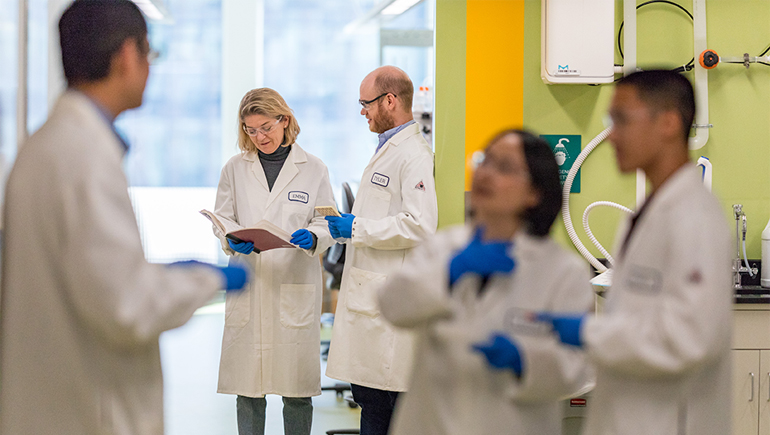
United States
New Zealand
Czech Republic
Netherlands
Switzerland
United Kingdom
Saudi Arabia
United Arab Emirates
Other Markets

Our R&D team
Learn more about the backgrounds, scientific pursuits and personal interests of members of our R&D team. These individuals are committed to pursuing Bristol Myers Squibb’s goal of discovering, developing and delivering transformational medicines to patients.

Scientific Director of Transgenic Discovery, Discovery Biotherapeutics Bristol Myers Squibb

Senior Vice President, Informatics and Predictive Sciences
Explore our r&d team.

Vice President, Head of Oncology Discovery, San Diego Site Head

Scientific Director, Discovery Myeloid Biology, Cancer Immunology and Cell Therapy

Vice President, Cardiovascular Discovery Biology and Translational Pharmacology

Head, Regional Clinical Operations Business Management, Global Development Operations
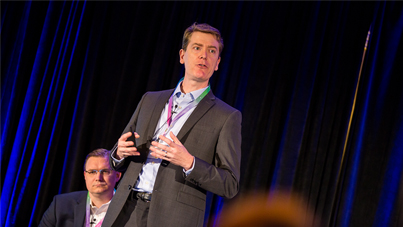
Vice President, Global Program Lead, Immunology, Drug Development

Senior Vice President and Head, Cardiovascular and Neuroscience Development, Global Drug Development

Vice President, Discovery Biotherapeutics, East Coast

Head of Immunology Clinical Development

Executive Director, Discovery Toxicology

Senior Director, Translational Research, Cancer Immunology and Cell Therapy Thematic Research Center

Senior Vice President, Head, Small Molecule Drug Discovery

Director, Scientific Operations and Strategy Immuno-Oncology and Cell Therapy Thematic Research Center

Senior Vice President, Cancer Immunology and Cell Therapy Thematic Research Center Seattle, WA

Associate Director of Strategy and Business Development for Cardiovascular and Neuroscience

Senior Vice President, Neuroscience Thematic Research Center
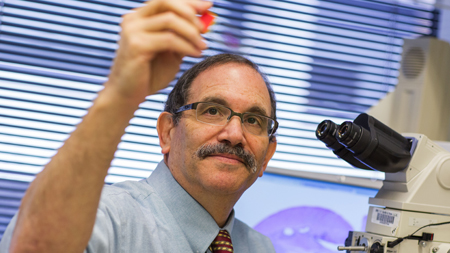
Director, Pathology, Discovery Toxicology

Senior Vice President, Head of Clinical Development, Immunology, Cardiovascular and Neuroscience

Executive Director, Early Clinical Development Brisbane, CA
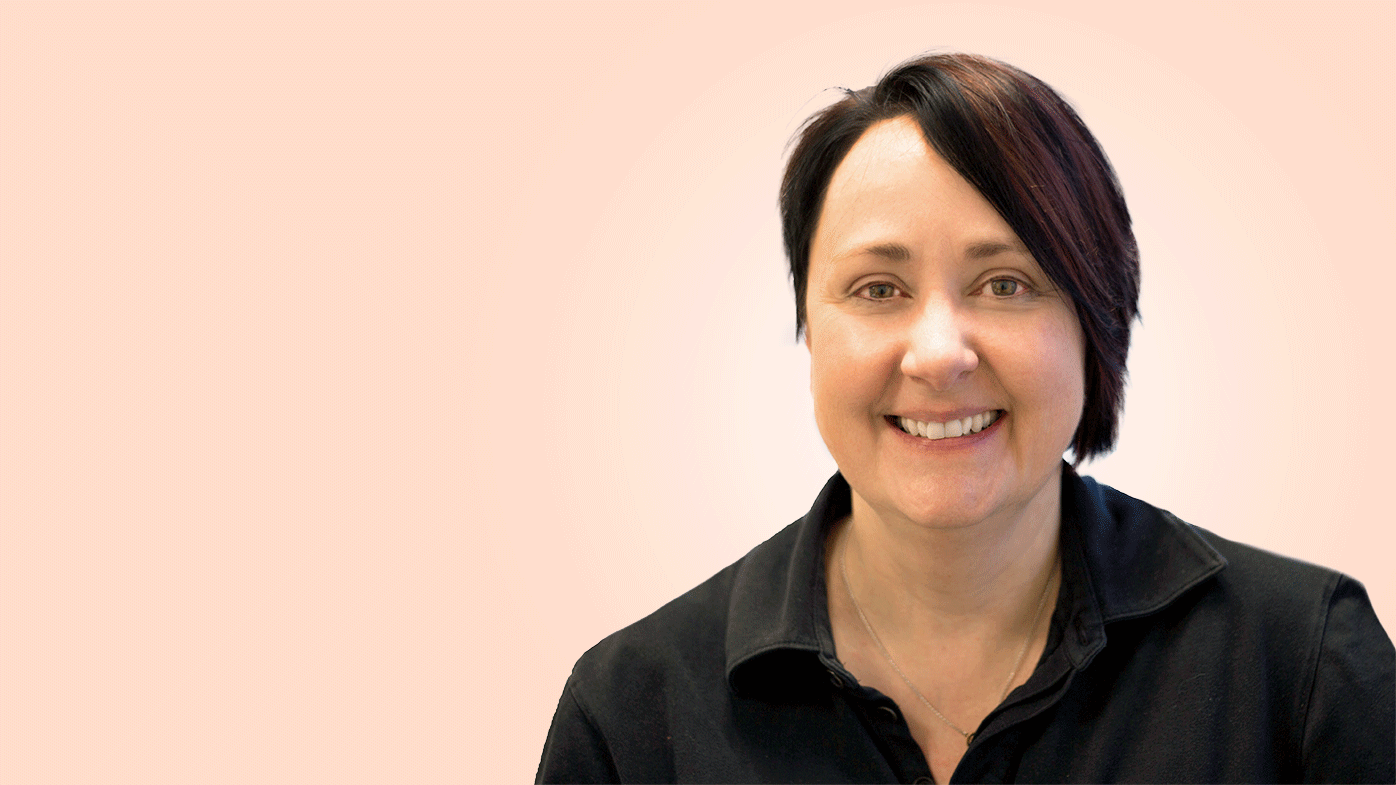
Senior Vice President, Head, Non-Clinical Research and Discovery Biotherapeutics Redwood City, California
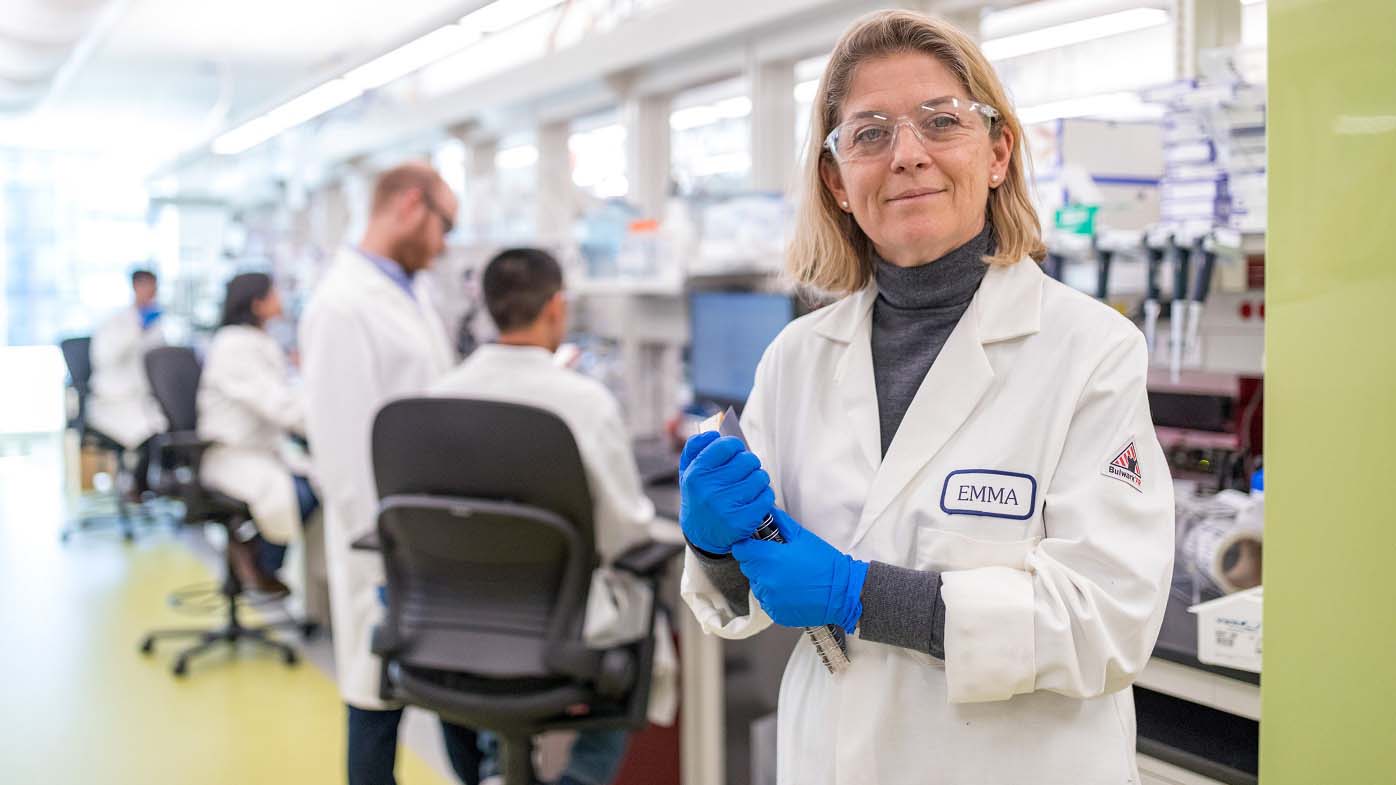
Head, Mechanisms of Cancer Resistance Thematic Research Center

Countrywide Medical Director, Germany, Global Medical

Scientific Senior Director

Executive Director, Immuno-Oncology and Cellular Therapy Translational Development

Vice President, Head of Early Clinical Development for Hematology, Oncology and Cell Therapy

Head, Global Research & Development STEM Strategy Bay Area, CA

Senior Vice President, Oncogenesis Thematic Research Center Brisbane, CA

Senior Vice President, Head of Global Program Leaders, Immunology, Cardiovascular and Neuroscience

Vice President, Global Program Lead for Cardiovascular Translation Assets

Senior Vice President, Global Biometrics and Data Sciences

Vice President and Head of Discovery, Immuno-Oncology and Cell Therapy Thematic Research Center

Vice President, Translational Bioinformatics, Informatics and Predictive Sciences

Senior Principal Scientist, Protein Homeostasis Structural Biology
The present-focused, future-ready R&D organization
Across engineered industries, the explosion in software has increased product complexity by an order of magnitude. Along with rapidly evolving technologies, fast-changing consumer preferences, accelerated product cycles, and the practical realities of globalized operations and markets, R&D departments are under unprecedented strain. As product variation grows and product portfolios expand, updating existing products compounds the already heavy load R&D organizations bear.
Yet amid these 21st-century challenges, R&D units are still following 20th-century models of organization—models not designed for today’s need for speed and the expanding web of interdependencies among all of the moving parts. The traditional component-based approach to R&D is no longer sensible in an era when digital and electronic systems are so thoroughly integrated with hardware. Still many companies struggle to shift toward an approach that focuses more on the function the customer wants, rather than the components that make the desired function work.
There is no one right way to organize R&D. But there are certain fundamentals that can help R&D organizations in advanced industries act more responsively and meet the burgeoning challenges they face today. From our work with clients and our extensive research, we’ve distilled a set of core design principles for R&D organizations and identified the important ones. By following these principles, companies can help their R&D organization serve as engines of innovation for outpacing competitors. And they can foster the agility organizations need in supporting collaboration among remote, distributed teams—as has become more important than ever in response to unpredictable external events.
A growing mismatch between design and function
Determining the right structure for the R&D organization has never been easy. The division of responsibility is a balancing act between the project-management organization and the R&D line organization, with inevitable trade–offs. Today’s R&D teams don’t have the luxury of following a sequential, piece-by-piece approach in which finished, designed components are handed off to testing at the end. Moreover, the teams need to be appropriately protected from the external and internal disruptions that the broader organization experiences, which today come with greater frequency.
As they’ve grown organically, many R&D organizations continue to operate with the same structures and processes they’ve used for years. Despite (or perhaps because of) the increasing inadequacy of those structures and processes, organizations don’t follow them consistently. Pet projects are often hard to kill, even long after their diminished promise becomes apparent. And because research effectiveness is hard to measure—and companies often don’t understand R&D costs or ways of working—the black-box image persists without challenge.
Thus, adhering to an existing structure isn’t enough: the shifting demands, the sheer volume of work and the growing complexity (much of it the result of software integration) make it incumbent on R&D organizations to reappraise their design. Instead, they can create new mechanisms to provide the coordination, transparency, governance, and risk protection R&D needs in the digital era.
A set of winning design principles
In the ideal R&D organization, responsibilities are clearly established, and interfaces between and among teams (internal and external) are seamless and transparent. These requirements, although not new, have become even more important of late, particularly when more teams are working remotely. R&D organizations that fulfill them can better meet further requirements—managing complexity actively and efficiently while staying focused on the future, and also maintaining the tools and capabilities for adapting to change.
Clearly delineate responsibilities for systems and end-to-end work
Historically, the R&D function has been organized according to field of expertise, components, or location, which has the effect of creating silos. Product properties are defined at the start of the development process, without being analyzed according to larger internal systems or user functions. Little attention is given to thinking in terms of the overarching goals customers want to achieve, or to the growing interdependencies as software and digital functions have pervaded almost every engineered product.
Many of the complications R&D organizations encounter today are the result of organizational interfaces that don’t match the product, along with a lack of transparency between groups. Take, for example, a feature such as lane-assistance for vehicles. Developing further advances in this function depends on a high level of coordination among teams developing steering systems, brake systems, and electrical systems. But too often that coordination occurs only late in design, perhaps even the final testing phase, by which point addressing problems becomes expensive and time-consuming. R&D organizations are more effective when they shift their orientation from components to user function, while keeping platform development stable to ensure a core of commonly used modules.
With such a shift, assigning end-to-end responsibility for functionality has become imperative. Companies can assign responsibility for the complete product, as well as for the individual system layers, under the “V” model shown in Exhibit 1, which imposes oversight as ideas progress from concept through to market release, series development, and finally upgrades.
The process moves from left to right. Under “Conception,” individual systems and their associated software are defined to fit customer demands and budget. Through early testing in the development process, issues and challenges become apparent early on. The right side of the V comprises testing and integration, which are conducted along the system layers. By breaking a product’s properties into requirements for systems and functions, the activities become transparent to everyone involved in development.
This approach enables iterative handshakes—more frequent interactions between concept owners and developers. Teams work together to translate properties into functional requirements. The approach also establishes dedicated responsibilities for complex functions and keeps the development process transparent. To coordinate and manage the interaction points, automotive companies tend to introduce central units that manage the whole integration process along the different development steps. These departments can be seen as a “stable backbone” within a dynamic development process, which helps improve planning for milestones and facilitates early failure detection. One machinery company, for example, set up quarterly integration meetings to align on priorities; the one to two days team members spend planning together gets them aligned for the next quarter’s work.
Perhaps the biggest benefit to assigning end-to-end responsibility is that it enables R&D to manage the interfaces and different development cycles between hardware and software development. Functionality owners coordinate the development of complex and interdependent components and features, creating technical guidelines and specifications that support consistency. They effectively safeguard the implementation and validate that the solution fulfills its requirements over its entire lifecycle.
Would you like to learn more about our Operations Practice ?
Keep functional interfaces across work sites to a minimum.
Companies can most effectively conceive of interfaces in terms of R&D’s geographic footprint—a balance taking into account which activities are performed where, and how the locations must interact. Minimizing functional interfaces across multiple sites and avoiding duplication of similar work are both important as well. Furthermore, to be cost-effective, location design can identify best-cost country sourcing for repetitive tasks, keeping in mind end-to-end responsibilities.
Dividing projects up among sites is usually less ideal, as people who work together in the same place tend to work more efficiently: earlier research found that with each additional development site for a given software product, productivity fell by about 14 percent (Exhibit 2.) Just the difference between one site and three sites amounts to a 37 percent decline in productivity.
Minimizing the number of handovers between sites—and making those that remain as smooth as possible—also helps. Distance between sites is not what matters; without the right management practices, a site across the city can seem as distant to employees as one clear across the country. But virtual teams can be as efficient as co-located teams, as long as the tools supporting the virtual work are utilized properly, communication is adapted accordingly, and everyone can participate on an equal basis.
R&D leaders can consider future roles and competencies when thinking about the physical design of the department. Where should the development of next-generation products start? How could a transition to new products be built for sites currently focused on legacy products? How will cost and availability figure into the overall network structure? The answers form a long-term site strategy that can help avert a talent crunch.
The right footprint model also builds in a detailed understanding of local requirements, such as interactions with suppliers, local regulations, and internally, the interdependencies with other departments or components. The sophistication of the design work, and the degree of conceptual work that will be done in a particular location, will inform the kind of competencies and technologies that will be needed. For example, one white-goods manufacturer carried out almost all development in its home market, later building a few local development centers in key markets to help adjust the products for local preferences, such as for refrigerator and freezer sizes, configurations, and color schemes.
Synchronize software and hardware development
Complexity in all its forms has increased markedly—product variations alone have exploded over the past two to three decades, driven largely by the rise of embedded software and digital capabilities.
But R&D protocols often fail to account for the unique challenges of managing the development of integrated software and hardware. Software and hardware development follow different development cycles and require different approaches to project steering. And when digital features or components aren’t explicitly considered in milestone planning, integration problems and delays are almost inevitable.
As essential as synchronizing development may be, it isn’t easy. In automotive, for example, map software generally takes about a year to develop, with frequent updates, while apps or innovative vehicle-control features (such as autopilot) may be updated monthly, with ongoing development and improvement. Contrast these cycle times with the hardware that runs navigation systems (which take two to three years to design and build), vehicle platforms (about seven years in the making) and basic vehicle components, such as heating systems and airbags—mature components that typically have a 10-year lifespan.
With such wide disparities in cycle times, transparency becomes crucial. The lack of it is a problem not only in concept development, but in delaying product launches as well. For complex functions, such as lane assistance, R&D units may have limited ability to measure how mature the product really is. When changes are made, teams may therefore fail to assess the implications on other features currently in development. Beyond cost overruns, delays, and risks to product integrity, poorly managed complexity invariably leads to finger-pointing among system teams as well as conflict between R&D and the project-management team.
R&D organizations have two options for managing the complexities of synching software and hardware development.
- Embedding software development within existing departments. This approach promotes integrated development—but in practice, processes are often designed from a hardware point of view, and software complexity is not managed effectively.
- Keeping development separate but coordinated. With this arrangement, individual technology components don’t get short shrift. The onus is on leaders to establish synchronization points to identify potential conflicts that would require escalation to senior management.
The approach to take is generally determined by the nature of the product, as well as the organization’s experience with software—bearing in mind that complexity will likely grow. Increasingly, services are developed not only within the engineering department but also within IT, creating still more interfaces and responsibilities, with implications for organization design.
Strike a balance between old and new technologies
When it comes to developing new technologies, R&D managers have three choices: segregate them completely in a separate unit; include them in the R&D organization, but keep them separate; or integrate them fully into the core R&D organization (Exhibit 3).

Taking supplier collaboration to the next level
Segregating the current and new technologies has its advantages. Unfettered by standard processes, separated units are free to realize their full potential. The R&D organization keeps budgets separate and shields the new technology from the noise of existing projects.
But this option can be a hard sell to management, as creating a new unit can be costly, labor-intensive, and harder to absorb into the existing structure. Beyond the break-in time to adapt to existing products and processes, segregation also limits the broader organization’s ability to transfer capabilities and knowledge, particularly given that cutting-edge technologies call for special (at times rare) expertise and training time for employees.
Short of total separation, there are essentially two ways to include new technology development within the R&D organization. Integrating new technologies fully into the existing organization helps transfer knowledge, and lets the new part of the organization tap into existing capabilities and processes, all of which helps in reaching scale faster. However, in this arrangement, there are risks—new technologies could be prematurely quashed by senior management, or if developed according to current methodologies, could yield less-than-optimal results.
An R&D makeover to sustain market leadership
A global production-equipment manufacturer had long viewed its R&D organization as a crucial source of competitive advantage. But the company’s rapid growth and increasingly complex product portfolio meant that more products were being developed in parallel. That led to even greater specialization among engineers and more technical interdependencies across modules. As the number of engineers and management layers grew, so did the number and complexity of interfaces, threatening the company’s rapid growth.
Historically, R&D groups had been organized in two types of departments.
- System functions, which handled the functionalities that met system specs and customer requirements, such as for productivity and machine precision.
- Engineering functions, encompassing specialties such as electronics, mechanics, software, and environmental controls.
These functions were required for developing the system modules and the system architecture needed for the integrity of the assembled machine.
Cutting complexity
As a first step in redesigning the R&D organization, R&D leaders made system function leaders responsible for tangible and testable machine modules. System leaders’ reports were given responsibility for the respective submodules. In that way, every production module and submodule would have a clear owner with end-to-end responsibility, from new-product introduction to third-line field-service support. Whereas before, each engineer worked on multiple products, under the new system each now works on only one business line and handles only one submodule at a time (Exhibit).
System-function departments are now primarily business-line dedicated. Each system function has a central architecture team that promotes commonality in the system modules’ roadmaps and the maximum reuse of module elements among business lines.
Engineering-function teams (such as software teams) are largely dedicated to modules or submodules. Leaders have the authority to deliver their technical roadmap with more stable, focused, and experienced people. Within each engineering function is a central architecture department that’s responsible for system design and standards (the left side of the V in Exhibit 1 in the main text) and for setting guardrails for module design and development. This structure also ensures integrity in the final product.
Responsive and future-ready
To maintain system integrity, shared platforms, and innovation- and knowledge-sharing across business lines, the company established several central teams. To manage competence (and continue building needed skills), the organization developed a taxonomy of critical competencies, assigned to VPs and managers and governed through an annual planning cycle.
The stable, multidisciplinary teams that characterize the new design have created a solid foundation for piloting and scaling agile ways of working in the product development teams. Since the launch of the new organization, more than 2,000 engineers have migrated to agile methods. But engineers aren’t the only ones working in new ways. By forging and executing the redesign as a team, R&D leaders have developed adaptive muscle, with the ability to adjust their organization to fast-changing requirements and environments.
Most often, the best bet is a happy medium, in which new technologies are assigned to a separate team but explored within the current R&D organization (see sidebar, “An R&D makeover to sustain market leadership”).
The right approach is also a function of the situation and the culture. Consider the electric powertrain in the automotive industry—the different manufacturers offer a sample of all of the archetypes.
To be future-ready, adopt new ways of working
The traditional waterfall development model that some organizations still follow is so protracted that products can be obsolete by the time they are released. Long development times become impracticable when businesses factor in the out-of-sync cycle times of software and hardware components. In addition, a siloed and fragmented organizational structure makes it hard to respond nimbly to new process requirements.
Fast-changing customer demands and rapidly evolving technologies have increased the premium for enterprises and their R&D organizations to be adaptable, flexible, and future-oriented. And the coordination, integration, and speed needed in R&D today call for new ways of working. These include agile methods that enable fast iterations and cross-functional, flexible teams that ensure that the concerns of all relevant stakeholders—people from different functional units, as well as the different engineering teams, project managers, and customer representatives—are addressed. For example, a team working on autonomous driving would include not only software engineers but also hardware engineers from the steering, brake-system, and overall car-design teams, as well as those working on user interface design.
To foster a future orientation within the R&D function, companies can adopt certain design features and practices, in particular those structures that promote agility:
- A flat organization in which teams are granted full responsibility to design solutions. This creates a strong sense of ownership among individuals
- End-to-end, cross-functional teams whose talent is drawn from all the relevant and traditional R&D functions. Often, teams are supported by individuals outside of R&D, such as marketing managers or customer representatives. Team membership is stable and changes only when projects are finished or strategic priorities change
- Pools of experts (both internal and external) that support projects with the talent they need
- Resource allocation that is flexible, shifting as needs change
- More co-location time for teams, wherever possible
- Role descriptions and rewards that align with the new organizational structure and targets
These practices usually suggest that the company might consider changing certain roles in the organization—particularly in light of the widespread need for more architects, as leaders are charged with empowering teams to foster innovation more than ever before. In fact, an automotive manufacturer saw its leadership transformation as a driving force for putting in place its new R&D organization.
A further question we are hearing is: how does all of this work in a remote working environment? The bulk of these practices can be implemented in a digitally enabled organization if co-location is not an option, with priority for practical matters such ensuring teams have sufficient bandwidth to connect as often as needed. Clear roles and targets will be especially important as well, as will an emphasis on empowering teams and individuals.
With ever-expanding product portfolios—from more product variation to additional software embedded in engineered products—R&D organizations tell us they are struggling to keep up pace. That makes the shift from a traditional, component-based approach to a functional all the more essential.
Change isn’t easy for this traditionally black-box area of the organization. Engineers themselves struggle with how to reengineer their own work processes, often not knowing where to start. To determine the right blueprint, it helps to step back and reflect on current performance and future needs by asking a few central questions:
- Do we have a clear way of addressing the complexity that comes from interfaces?
- How are we handling interdependencies between systems? Is complexity increasing, and if so, are we well set up for the future demands?
- Do we have what it takes to adapt to a larger proportion of software development in our R&D?
- Are we sufficiently agile and flexible to adjust our focus based on changing demand? Could we handle more frequent changes in demand?
- How prepared are we for future technologies? Do we have the right structure in place to acquire and scale them?
- Do we have sufficiently clear roles, interfaces, and end-to-end responsibilities within R&D between teams and sites and to other departments?
There is no master formula for making this shift—nor could there be, given the differences across industries and from organization to organization—but certain principles prevail. Abiding by the principles outlined here can provide a blueprint needed for integration at the right points, and the much-needed transparency across R&D. If R&D is the company’s engine of innovation, its own transformation is more than a matter of securing market share, it’s about being built for a fast-changing present in order to secure the future.
Anne Hidma is an associate partner in McKinsey’s Amsterdam office, where Vendla Sandström is a consultant, and Sebastian Küchleris a partner in the Munich office.
Explore a career with us
Related articles.

COVID-19: Implications for business

Unlocking enterprise efficiencies through zero-based design
- How to Work with Us
- Why Ukraine
- How to Build an R&D Team: Best Practices

There are many considerations in building a good R&D team. Questions like “how to do R&D for business?”, “Where do I hire R and D staffing?”, “What R and D services can I establish on my own?”, “Do I need to build an R and D building or several R&D centers?” may come up. To set up a good R&D team at affordable research and development costs , you need to:
- Understand what you can and cannot do on your own
- Know the R&D team structure you need
- How to implement research and development
- Consider R and D staffing offshore nearshore options
How to Structure a Research and Development Company
Determining how to structure a Research and Development (R&D) company and corresponding r&d centers is not easy and has several considerations. However, there are 2 general R&D team structure frameworks that most businesses and organizations use as a guide. The structure that you use should fit your business structure and R&D needs.
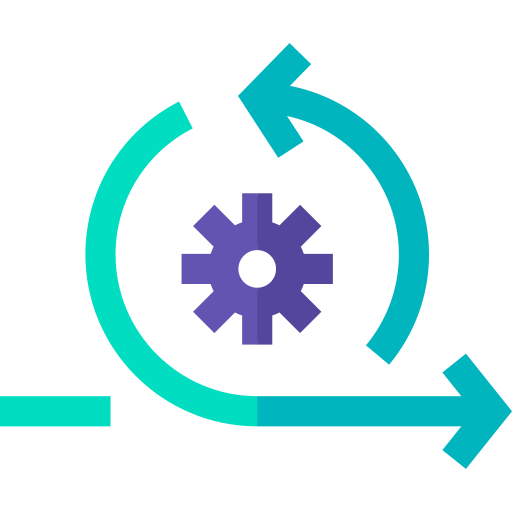
Separate Functional Form
R&D departments manage R&D team and experts capable of executing the entire product development process for the individual department R&D project. This structure requires R and D teams with high levels of collaboration and expertise in the entire product development process for their assigned department to effectively function.

Product Line Form
For the second structure, each step in the R&D product development or improvement project is handled by separate departments. This enables businesses to outsource certain steps or functions in the R&D product development or improvement to third-party R&D service providers.
Ready to take your business’s innovation to the next level? Invest in a dedicated R&D team today! >>>
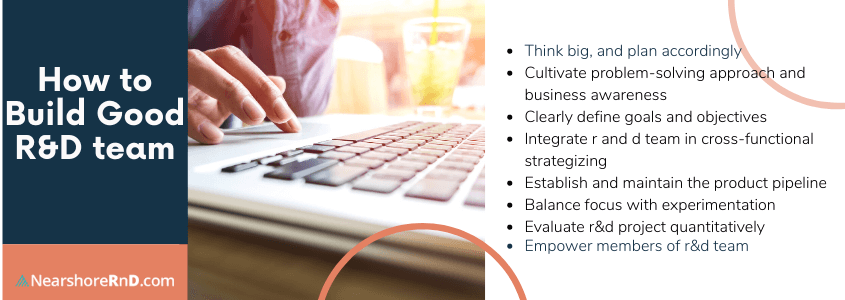
How to Implement Research and Development and Build Good R&D Team

Think Big, and Plan Accordingly
Think globally, act locally. This means that implementing a good R&D team needs a global overarching vision with a corresponding action plan for acting locally. A good R&D team needs structures and processes that will be effective in developing and/or improving products for diverse markets, whether it be local or global.

Cultivate Problem Solving Approach and Business Awareness
Successful products developed or improved by the engineering R & D team are launched in future business strategies. The management team should plan for the impact of key industry drivers when making any decision.
It is also essential that R&D focuses on addressing consumer feedback and meeting consumer needs. This approach ensures that products developed by the engineering R & D team are relevant to the consumer base and adds value to the business.
Businesses should be able to plan, monitor, and adapt as technology evolves and grow. This will ensure that they can utilize new technology to improve their products or develop new products that meet consumer needs. This will also help keep the business relevant and continuously grow.

Clearly Define Goals and Objectives
Be strategic and in your decision making and distinguish your goals and objectives appropriately according to the level needed. Consider the company’s overall strategic vision and goals and integrate other internal and external insights and information in developing long-range business and R&D plans.
Ensure that R&D plans and projects align with the company’s overall goals and business strategies. This ensures that the R&D team and its projects add value to the business and influence and enhance the business strategy. Define SMART goals and objectives. Ensure that the R&D team and strategic goals and objectives are specific, measurable, attainable, relevant, and time-bound. This ensures that your goals are clear and can be realized by the department.
Ready to take your research and development to the next level? Build a winning team with our expert R&D professionals.

Integrate R and D Team in Cross-Functional Strategizing
R&D is not an isolated department but is part of a network of departments that support a business. The business must establish a shared viewpoint and understanding of its R&D portfolio and R&D centers. Everyone is now on the same page regarding the goals and objectives of the engineering R & D team. This also collectively builds commitment to the successful execution of their projects.
Include representatives and experts from different functions (R&D, manufacturing, sales, marketing, consumer assistance) when planning for R&D strategies or projects. This approach will help build and maintain the commitment to research of every department involved.

Establish and Maintain the Product Pipeline
Ensure that their R&D team and R&D centers have a smooth, consistent, and reliable flow of products and improvements. This reduces the risk of delays, overcharging, failed product launches, and problematic products. This shows that your R&D team is reliable, efficient, and effective in its workflow.
A streamlined product pipeline also helps balance the short-term and long-term interests and the technology strategy of the business. Over time, streamlining processes will help added value to the company.

Balance Focus with Experimentation
A successful R&D team can find the balance between core idea focus and experimentation. Experimentation allows for ideation and discovery of innovation; the eureka! moments that many aims for in R&D. On the flip side, focusing too much on core ideas can also lead to missed opportunities and stagnation. R&D cannot afford to focus resources more on exploration than idea development, or vice versa. A business should have a healthy balance of idea exploration and a focus on core ideas.
A good R&D team should also strive for a balance between R&D projects with incremental product improvements and projects with potential for significant breakthroughs. This will lead to more sustainable R&D and business success. Always put focus and effort on projects that create value for the business.
Do you need a dedicated team of experts to lead your research? Look no further than our R&D team! >>>

Evaluate R&D Project Quantitatively
Evaluating projects quantitatively ensure equitable or unbiased assessment of R&D projects. This ensures that there is transparency among individuals and business representatives involved. Quantitative evaluations measure the impact R&D project outputs on the business overall against their initial expected value at the start.
Quantitative evaluation of your R&D is also part of measuring its effectiveness. The effectiveness of an R and D team also factors in the efficiency of the departmental processes, product or improvement turnaround time, valuation of project output, cost-effectiveness, the achievement of set goals, and others.
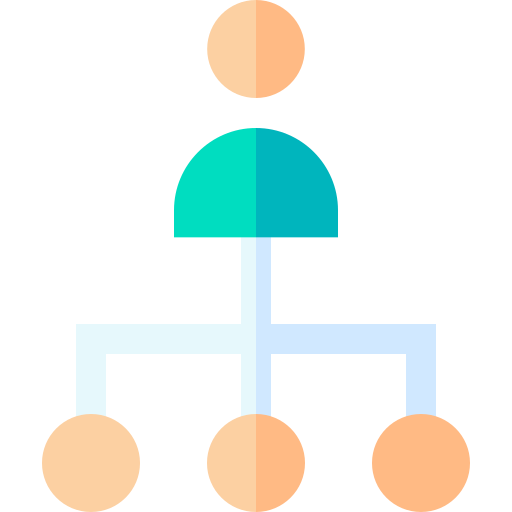
Empower Members of R&D Team
A good R&D team is one that hires the professional best fit with the business needs and can provide them with opportunities for further professional growth and development. Creating a learning framework – individual and organizational learning – for your R&D team ensures that there is continuous learning among your R&D team. The learning framework can also incorporate measures to enable learning from other businesses and R&D organizations, as well as organizational post-product evaluations and audits.

5 Reasons to Have a Strong R&D Team
In the present-day cutthroat business environment, being innovative is crucial to maintaining an edge in the market. Thriving companies recognize the need to continually create new products and services that cater to the ever-changing demands of their customers. Consequently, having a sturdy RnD team is essential, even for smaller organizations. Here are five persuasive grounds why you should channel resources into powerful R&D teams:
- Competition: To differentiate yourself in your industry, you must be innovative. An effective R and D center team ensures that you are always ahead of the game by delivering fresh and stimulating products that distinguish you from your competitors.
- Risk Minimization: A proficient R and department team can aid you in determining which products or services are worth investing in, saving you valuable resources. By conducting exhaustive research, they can ascertain whether there is a market demand for your next big idea before you commit to it.
- Independent Reviews: An RD team provides impartial evaluations of your products, giving you an accurate idea of their performance. This allows you to detect opportunities and make informed decisions before launching your products.
- Productivity: R&D teams also evaluate your business operations to discover more effective and cost-efficient ways of conducting business. This can help you save resources while enhancing productivity and profits.
- Marketing: RnD department teams can also assist you in marketing by proposing fresh and exciting ideas to reach your customers. By collaborating with your marketing team, they can help you develop targeted campaigns that resonate with your audience and drive sales.
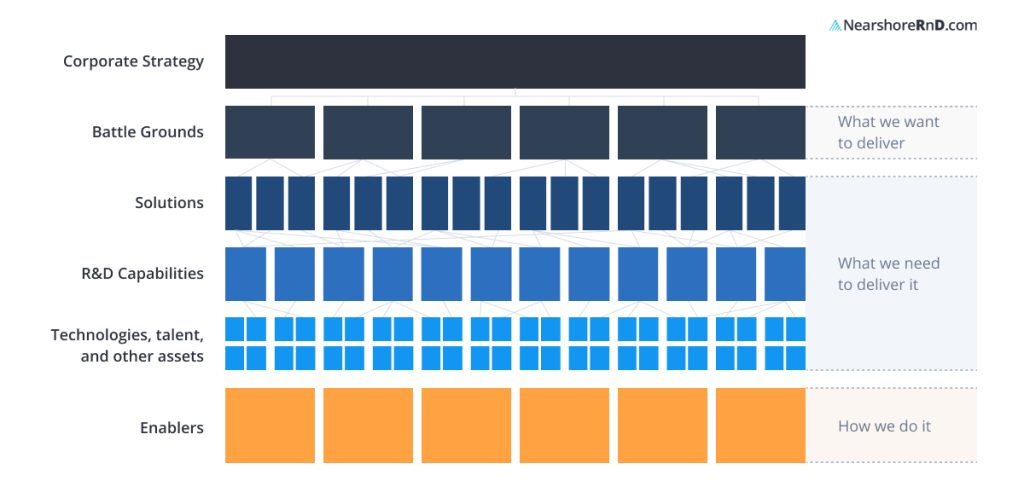
Why a Good R&D Team is Crucial
A great RD team makes a huge difference to a business. Not only does it help the business grow, but it also helps you stand out from your competition. Customers are not always loyal and they are always on the lookout for the next, bigger and better product they can use to fulfill their needs. R and D is the backbone of successful businesses around the globe and it is because it identifies customers’ needs before it becomes general knowledge.
There is a very good reason for multinational companies to spend 20% of their earnings on RD. It helps them stay ahead of the curve, and offer customers the most updated ideas before their competition!
RD not only allows a company to identify its customers’ needs but also helps with streamlining internal processes, which shows the bottom line at the end of the day.
Leading software companies around the globe are spending about 10 to 15% of their earnings on RandD to keep up with their competition. This does not just count for global corporations, R and D can be beneficial to small and medium businesses as well!
Calculating what you should spend on RD can be difficult, so it is wise to approach a consultant or outsourcing agency and ask them for assistance.
R n D is worth the spend and there is rarely a situation where you will find that the return on your spend is not worth it!
Outsourcing Research and Development (R&D): Where to Get Reliable R and D Services
A major cost-effective measure to establish R&D for your business is to outsource the entire process to an R&D service provider. An R&D service provider will be able to assist you with:
- Determining team size and structure
- Establish R&D strategy and plans
- R&D staffing recruitment and onboarding
- Guide on how to set up R&D lab or R and D facility
- R&D facility establishment
Partnering with an outsourcing R&D service provider will ensure that you can get the best possible Research and Development (R&D) facility and Research and Development teams that your business needs with minimal investment.
Get your free consultation now! Learn how to build your powerful R&D team in Ukraine!
Benefits of r&d.
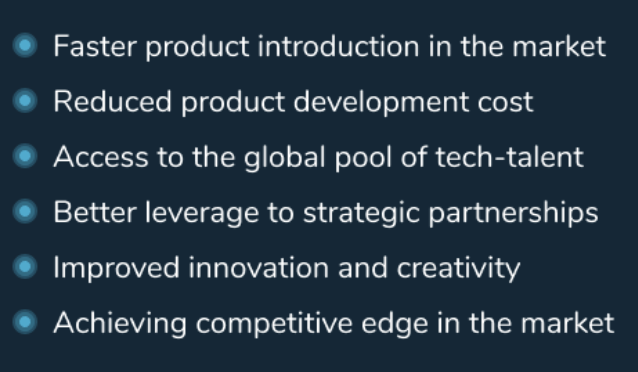
- R&D in Ukraine: Why Establishing an R&D Lab in Ukraine Is So Beneficial for Foreign Companies
- Research and Development Costs: Definition, Examples and More
- R&D Consulting: How to Get Help in Developing R&D Solutions
- R&D Engineer: Where and How to Hire Top Tech Talent

© 2024 Nearshore R&D.
Website Navigation for Screen Readers
- Return home
- Go to header navigation
- Go to search form
- Go to content region
- Go to footer region

Research Development Team

COVID-19 Research Administration Preparedness
The rapid evolution of the COVID-19 pandemic requires the university to accelerate its response to this unprecedented challenge.
The Research Development Team (RDT) at Johns Hopkins University promotes and encourages collaborative research across disciplines, schools, and institutions by assisting project teams with large-scale proposal development.
Our services.
- Managing and facilitating the pre-award phase for teams who submit large grant proposal opportunities that support multidisciplinary and collaborative research (e.g.: NIH’s project grants (P01, P30, etc.) and cooperative agreements (U19, U54, etc.))
- Grant writing and editing services via the Editorial Assistance Services Initiative (EASI)
- Offering University-wide training and workshops that are sponsor/grant-type specific
- Providing templates for common sections of federally-sponsored proposals
- Distributing weekly emails with limited submission funding announcements
- Distributing monthly funding opportunity emails with internal JHU funding sources and external grant opportunities for graduate and postdoctoral students and early-career faculty
- Connecting PIs with various resources across the university
- Managing the university-wide NSF GRFP Fellowships
Contact Us: [email protected]
Vice Provost for Research
265 Garland Hall 3400 North Charles Street Baltimore, MD 21218
(443) 927-1957
- External link to Twitter
- Research at Johns Hopkins
- Bloomberg Professors
- Awards Programs & Initiatives
- Research Development
- Research Administration
- © 2024 Johns Hopkins University
- University Contacts
- Emergency Contact Information
- University Policies and Statements
Website Footer Navigation
- Jump to content region
Advisory boards aren’t only for executives. Join the LogRocket Content Advisory Board today →

- Product Management
- Solve User-Reported Issues
- Find Issues Faster
- Optimize Conversion and Adoption
Utilizing research and development (R&D) to drive innovation

In 2019 alone, organizations around the world spent $2.3 trillion on research and development (R&D). Companies know that research and development is essential for growing as a business. Choosing to avoid R&D practices can easily become the choice between a successful or unsuccessful product.

R&D is not an optional phase for organizations. It provides numerous benefits like gaining a competitive advantage, responding to customer needs, and driving success. R&D also helps minimize product development errors since all choices are data-driven.
In this article, you will learn what research and development is, the role it plays in product development, and how you can implement it within your product team.
What is research and development (R&D)?
Research and development provides insights into how the market is responding to your product and helps you discover gaps in an industry that could be leveraged to create a competitive advantage. It’s a crucial part of aligning customer needs with your product capabilities.
R&D can also ensure that your company is creating value that aligns with your organization’s goals. Strategic alignment between the company vision and R&D will create innovative products that drive your company forward.
What is the role of research and development in product development?
R&D lays the foundation for product innovation and development. R&D activities help create new products, improve existing ones, and drive a company’s competitiveness.
The first step of the product development lifecycle is research and development (R&D). If you don’t have high-quality R&D, it affects the entire lifecycle of a product. Your organization could end up spending resources on an idea that’s not verified by accurate research.
R&D provides the necessary and actionable insights to inform and guide product development. Meanwhile, product development focuses on bringing validated ideas to market. Ultimately, R&D lays the groundwork for creating new or improved products while product management encompasses the entire lifecycle of a product.
Does product management fall under R&D?
Product management and R&D have separate, but interconnected functions within an organization. Product management covers many responsibilities including creating and selling the product. On the other hand, research and development hones in on identifying trends in your industry and target audience and using that information to help you adapt to the changing market.
Despite the connection between product development and R&D, product managers aren’t usually heavily involved in both spheres. You might find that your own bias affects research. Because of this, PMs often use skilled researchers who take charge of the R&D process and provide them with their findings.
What are the expenses of R&D?
Many organizations may look at the bill for research and development and hesitate to approve it. Labor expenses alone cost organizations $372 billion in 2020.

Over 200k developers and product managers use LogRocket to create better digital experiences
But if you’re not willing to pay for R&D, you risk giving up a competitive advantage. Many industries reinvest as much as 30 percent or more of their earnings before taxes, interest, depreciation, and amortization (EBITDA) into innovation research.
While R&D expenses may seem costly, your organization can’t afford to let competitors become more successful than you.
Research and development steps
Every organization will approach R&D differently. In general, though, research and development for product management may include the following steps:
- Define the objective — Determine the objectives of your research to guide the data collection process. Some examples include validating product ideas, testing the user experience, or finding gaps in the market
- Data collection — Whether it’s qualitative or quantitative data collection, ensure you are using unbiased methods to receive accurate results
- Analyze data — Data analysis looks for trends and other patterns that get turned into actionable insights
- Communicate results — Key stakeholders like executives and investors will want to know the R&D results, so it may be necessary to share a presentation with them
- Prototyping and MVP testing — Create prototypes or minimum viable products (MVPs) of your product idea and share them with users to gather feedback
How do you develop a R&D strategy?
Try to adopt a willingness to be bold with your R&D strategy. Oftentimes, organizations have a growth goal, but only approve “safe” projects. By doing so, you may limit yourself to your current market share, instead of discovering new possibilities for innovation.
Ultimately, an R&D strategy is what ensures innovation is happening at a company. Aligning the R&D strategy with product management goals is crucial to the overall success of an organization’s vision.
Developing a research and development strategy involves a few key considerations:
- Align company’s goals with R&D — What goals will R&D support? This may require executives to stay in communication with R&D to receive data-driven insights and evolve as needed
- Let R&D discover what the best capabilities are for building a product — R&D teams tend to have a better understanding of emerging technologies and how they can improve the organization and the products
- Focus on investing in the R&D team — You may want to emphasize attracting or training top talent to be part of your R&D team
Research and development example
R&D fuels product innovation and provides organizations with a competitive edge. Many organizations share their R&D strategies and insights with consumers. One example is at Proctor and Gamble (P&G).
Let’s take a closer look at how R&D informed P&G’s creation of Verso Vita. P&G wanted to reduce the use of fossil-sourced plastics and use more recycled content. This goal came out of a problem with recycling polypropylene (PP), since it often kept the color and smell of the previous product.
R&D needed to create a solution for this issue and created the Verso Vita process to restore PP to its original quality. The resulting Verso Vita process uses less energy than it takes to create a new PP.
More great articles from LogRocket:
- How to implement issue management to improve your product
- 8 ways to reduce cycle time and build a better product
- What is a PERT chart and how to make one
- Discover how to use behavioral analytics to create a great product experience
- Explore six tried and true product management frameworks you should know
- Advisory boards aren’t just for executives. Join LogRocket’s Content Advisory Board. You’ll help inform the type of content we create and get access to exclusive meetups, social accreditation, and swag.
With this new product, P&G moved closer towards its sustainability goal of having 100 percent recyclable or reusable packaging by 2030.
Key takeaways
The ability to make bold decisions with data-driven insights can help ensure your R&D expenses are creating value for your business and customers, but gaining those insights requires strategy.
Ensuring your R&D strategy aligns with your company goals is fundamental to success. Research and development is the first phase of a product life cycle, and it creates the foundation for creating an impactful product.
Featured image source: IconScout
LogRocket generates product insights that lead to meaningful action
Get your teams on the same page — try LogRocket today.
Share this:
- Click to share on Twitter (Opens in new window)
- Click to share on Reddit (Opens in new window)
- Click to share on LinkedIn (Opens in new window)
- Click to share on Facebook (Opens in new window)
- #collaboration and communication
- #product strategy

Stop guessing about your digital experience with LogRocket
Recent posts:.

An overview of functional requirements
Functional requirements describe the desired outcome from the user’s perspective so it’s easier to understand the end result.

Leader Spotlight: Maintaining continuity across online and offline channels, with Alvin Hill III
Alvin Hill III, Group VP, Digital and Ecommerce at Sally Beauty, talks about bridging the gap between digital and in-store experiences.

A guide to decoding switching costs
You can leverage switching costs to your advantage to hold onto customers and make them less likely to want to switch.

Leader Spotlight: Redefining digital health, with Maximilian Maile
Maximilian Maile talks about redefining digital health by providing flexibility for patients to connect with healthcare.
Leave a Reply Cancel reply

- Research Process
Research Team Structure
- 4 minute read
- 88.6K views
Table of Contents
A scientific research team is a group of individuals, working to complete a research project successfully. When run well, the research team members work closely, and have clearly defined roles. Every team member should know their role, and how it plays into the project as a whole. Ultimately, the principal investigator is responsible for every aspect of the project.
In this article, we’ll review research team roles and responsibilities, and the typical structure of a scientific research team. If you are forming a research team, or are part of one, this information can help you ensure smooth operations and effective teamwork.
Team Members
A group of individuals working toward a common goal: that’s what a research team is all about. In this case, the shared goal between team members is the successful research, data analysis, publication and dissemination of meaningful findings. There are key roles that must be laid out BEFORE the project is started, and the “CEO” of the team, namely the Principal Investigator, must provide all the resources and training necessary for the team to successfully complete its mission.
Every research team is structured differently. However, there are five key roles in each scientific research team.
1. Principal Investigator (PI):
this is the person ultimately responsible for the research and overall project. Their role is to ensure that the team members have the information, resources and training they need to conduct the research. They are also the final decision maker on any issues related to the project. Some projects have more than one PI, so the designated individuals are known as Co-Principal Investigators.
PIs are also typically responsible for writing proposals and grant requests, and selecting the team members. They report to their employer, the funding organization, and other key stakeholders, including all legal as well as academic regulations. The final product of the research is the article, and the PI oversees the writing and publishing of articles to disseminate findings.
2. Project or Research Director:
This is the individual who is in charge of the day-to-day functions of the research project, including protocol for how research and data collection activities are completed. The Research Director works very closely with the Principal Investigator, and both (or all, if there are multiple PIs) report on the research.
Specifically, this individual designs all guidelines, refines and redirects any protocol as needed, acts as the manager of the team in regards to time and budget, and evaluates the progress of the project. The Research Director also makes sure that the project is in compliance with all guidelines, including federal and institutional review board regulations. They also usually assist the PI in writing the research articles related to the project, and report directly to the PI.
3. Project Coordinator or Research Associate:
This individual, or often multiple individuals, carry out the research and data collection, as directed by the Research Director and/or the Principal Investigator. But their role is to also evaluate and assess the project protocol, and suggest any changes that might be needed.
Project Coordinators or Research Associates also need to be monitoring any experiments regarding compliance with regulations and protocols, and they often help in reporting the research. They report to the Principal Investigator, Research Director, and sometimes the Statistician (see below).
4. Research Assistant:
This individual, or individuals, perform the day-to-day tasks of the project, including collecting data, maintaining equipment, ordering supplies, general clerical work, etc. Typically, the research assistant has the least amount of experience among the team members. Research Assistants usually report to the Research Associate/Project Coordinator, and sometimes the Statistician.
5. Statistician:
This is the individual who analyzes any data collected during the project. Sometimes they just analyze and report the data, and other times they are more involved in the organization and analysis of the research throughout the entire study. Their primary role is to make sure that the project produces reliable and valid data, and significant data via analysis methodology, sample size, etc. The Statistician reports both to the Principal Investigator and the Research Director.
Research teams may include people with different roles, such as clinical research specialists, interns, student researchers, lab technicians, grant administrators, and general administrative support staff. As mentioned, every role should be clearly defined by the team’s Principal Investigator. Obviously, the more complex the project, the more team members may be required. In such cases, it may be necessary to appoint several Principal Administrators and Research Directors to the research team.
Elsevier Author Services
At every stage of your project, Elsevier Author Services is here to help. Whether it’s translation services, done by an expert in your field, or document review, graphics and illustrations, and editing, you can count on us to get your manuscript ready for publishing. Get started today!

Writing a Scientific Research Project Proposal

Confidentiality and Data Protection in Research
You may also like.

Descriptive Research Design and Its Myriad Uses

Five Common Mistakes to Avoid When Writing a Biomedical Research Paper

Making Technical Writing in Environmental Engineering Accessible

To Err is Not Human: The Dangers of AI-assisted Academic Writing

When Data Speak, Listen: Importance of Data Collection and Analysis Methods

Choosing the Right Research Methodology: A Guide for Researchers

Why is data validation important in research?

Writing a good review article
Input your search keywords and press Enter.
- What is R&D? Its role in business and how it relates to R&D tax credits
What is R&D? Its role in business and how it relates to R&D tax credits

In order to understand the role and impact of R&D, it is useful to define research and development, explore its role in business and its wider importance. This will put us in a better position to look at how R&D is funded including via the government’s powerful R&D tax credit incentives.
What does R&D stand for?
R&D stands for research and development. What R&D represents in a business context and its power is a much wider and more complex area that we will now explore.
What is research and development?
Research and development is the generation of new knowledge. In a business context, it is an activity that companies undertake in order to develop new products, processes or services, or improve those that already exist. In order to do this, businesses often take on risk. This is because uncertainties exist around if what they are attempting is technologically feasible, or, more commonly, they don’t know how they will achieve their objectives in practical terms.
R&D is an essential function for many businesses. Launching new offerings or improving existing ones is a way for a business to remain competitive and make profit.
When developing a new product, process or service, or refining an existing one, R&D is one of the earliest phases. Experimentation and innovation is often rife at this stage, along with risk. The R&D cycle often begins with ideation and theorising, followed by research and exploration and then into design and development.
What sectors does R&D occur in?
Research and development occurs across a wide range of sectors and industries, and in companies of all sizes. These range from intensive R&D industries that rely heavily on R&D projects like pharmaceuticals , life sciences , automotive, software and technology to areas like food and drink. R&D also plays a major role in the construction industry, in particular in manufacturing and engineering.
Types of research and development
All R&D tends to start with ideas and theories – this can relate to identifying issues or new opportunities. The R&D process then focuses on exploring and researching those ideas, seeing what’s feasible. There are two main types of research within R&D – basic research and applied research.
- Basic research is all about acquiring knowledge and using it to build understanding and intelligence that a business can use to its advantage. This knowledge can be the foundation for further R&D projects and feed into strategic business decisions.
- Applied research is a lot more defined, and often looks to achieve a specific objective. This could be using a new technology, reaching a new market, improving safety or cutting costs. Applied research is often what leads to the development phase.
The design and development phase is all about taking an idea and making it into a product or process. Effectively, it’s about translating the research into a commercial product or service. It often involves designs, prototyping, trials, testing and refinement.
Prototyping is key to the development phase as it allows you to identify and overcome issues, and improve the design. Eventually, for those in manufacturing development, you move into manufacturing trials where you look to produce the product on a larger scale.
R&D can be set-up to look at different outcomes as follows:
New product research and development
R&D and product development often go hand in hand. Rapid changes in consumer demands and emerging technologies means there’s always a need to adapt. Before developing new products, you need a deep understanding of the market and the user needs. This lays the groundwork for the development of the new product.
Various concepts are generated and tested at the outset. These can then be prototyped for further research and testing.
Improving existing products and processes
The continual evaluation of existing products, services and processes is also a key part of R&D. If a product, service or process is no longer profitable or adding value in a market then it risks stagnating.
It could also be that technology has been developed that could facilitate improvements that may cut costs, make efficiency gains or improve safety. This can include improvements to the manufacturing and production processes of the product.
Legislative changes or shifts in user wants can also mean a product or process must change or evolve to remain viable.
Research and development examples
What R&D looks like varies across industries, sectors and companies. It can include large R&D projects or everyday R&D activities. Take a look at our case studies to see some real life R&D examples.
R&D projects
Research and development projects are set up to achieve a range of objectives and business needs. These could be around introducing a new product or service, improving an existing process or utilising a new technology.
Often these R&D projects will have unknowns and uncertainties at their core – and the R&D is aiming to resolve these. It is this uncertainty that forms a core aspect to the definition of R&D for tax purposes.
An example of an R&D project could be to migrate a legacy system onto the cloud, automate an aspect of the manufacturing process, or utilise new materials to improve performance.
Research and development in business
With emerging technologies and fast-changing markets, R&D in business is more important than ever. Although many businesses have an R&D function, how R&D actually looks on the ground varies dramatically. R&D intensity also differs dramatically between industries and individual companies. We will explore this in a little more detail.
What is R&D in business?
Businesses will approach R&D in different ways, with different organisational structures implementing different R&D strategies. How R&D is leveraged internally also varies dramatically between businesses, having a significant bearing in terms of its overall impact.
Some businesses won’t have the capability to do R&D in house so will outsource their R&D, relying on others to drive innovation. Some businesses choose to outsource their R&D while others have R&D departments entirely dedicated to R&D.
R&D is a complex function within any business and often comes with its challenges. Many R&D leaders struggle to reduce development times as well as plan and roadmap more effectively for the future. Building a culture of innovation across a business through R&D is often a goal for many businesses but one that is also hard to achieve.
R&D strategy
It’s not enough to simply carry out R&D. In order to make the most out of an R&D function, you need to strategise. Regardless of your R&D objectives, whether you want a competitive edge, a first mover advantage to capitalise on a new technology, to keep up with a competitor or break into a new market – how you plan and strategise around R&D is essential.
An R&D programme that is strategic will reap benefits. When combined with R&D tax credits, it becomes even more advantageous. You may want to adapt your R&D processes and planning to make more use of R&D tax credits. The ultimate goal is for R&D to permeate a company’s culture and approach to business.
The uncertainty at the heart of the potentially most lucrative R&D projects can be mitigated financially by the use of R&D tax credits. You can get rewarded for taking more risks. This helps effect a change in mindset when approaching risky projects. This is where our sector experts and chartered tax advisers come in. At ForrestBrown, we work closely with businesses to help them make the most of their R&D.
How to promote a culture of R&D in your business
Read more about the benefits of promoting a culture of R&D in your business.
R&D costs
Research and development can be expensive. Emerging tech and highly specialised staff, all come with a price tag. The fact that the costs are upfront without any guarantees of ROI understandably makes many CEOs apprehensive. Yet it remains an essential function and R&D spending needs to be factored into budgets.
In some businesses, R&D expenditure can be one of the biggest outgoings. There are annual lists published of those companies that spend the most on R&D – Amazon, Samsung, and Apple spend billions of dollars on R&D and frequently top these lists.
The good news is that many of the R&D costs can be recovered with R&D tax credits. There are others though that don’t qualify. You can see a detailed breakdown of qualifying R&D costs here . As a business, you need to weigh up the total project cost against the qualifying costs for R&D tax credits, then decide if your project is feasible.
R&D investment
Although the costs are high, by investing in R&D a business is investing in their future capabilities. R&D investment is a good way for a business to stay competitive and keep up with shifting customer demands. Those businesses that invest in R&D can receive different forms of funding including R&D tax incentives. In terms of R&D tax credits, there’s the SME incentive as well as the RDEC incentive for large companies and grant-funded SMEs .
Find out more about ForrestBrown’s RDEC services for large companies .
R&D departments
Some businesses will have a small team responsible for R&D or just pick up R&D activities across various teams and individuals on a more ad hoc basis. Other companies have a dedicated R&D department. Larger companies may even establish R&D centres – these can give them access to local R&D leaders and specialised R&D functions.
What is an R&D department?
An R&D department can contain a whole range of professionals, from R&D engineers and chemists to R&D managers responsible for the outputs. Sometimes you will have R&D leaders that look to drive the R&D department in a business.
The role of an R&D department?
The role of an R&D department is to keep a business competitive by providing insights into the market and developing new services / products or improving existing ones accordingly. The future growth of the business sits in a large part with the R&D department.
The R&D department will have a range of responsibilities. This can be everything from understanding a target market’s needs to looking at new products to quality control.
Elmelin go into good levels of detail around the role of an R&D department .
Outsourcing R&D
Businesses of all sizes make the decision to outsource their R&D. It’s not always viable to carry out R&D in-house. R&D outsourcing means you engage other organisations to help support or run your activity. These partners can then provide you with something that you can use as a business. This spans everything from independent R&D labs to university research organisations to clinical research organisations.
It’s always worth a business considering what R&D activities they can bring in-house as this can be beneficial. In particular, in terms of R&D tax credits. We use a few worked examples to explore who can claim for R&D in complex projects.
R&D and innovation
Research and development is closely linked to innovation. Innovation is a broad term and can be difficult to define. It often refers to those ideas, products, services, and methods/processes that are new and different. R&D activity and projects is one of the main ways a business will seek to innovate.
When it comes to R&D activity, innovation can mean new to your business or genuinely unique. InnovateUK summarise this: “‘new to me’ innovation encompasses proven technology being applied in new and creative ways. Whilst the technology itself might not be brand spanking new, the application or product is novel.”
Although not all R&D leads to innovation, it’s unlikely that innovation occurs without some degree of R&D.
The definition of innovation for R&D for tax purposes is narrower. This means that R&D tax credits can’t be a substitute for innovation. R&D for tax purposes focuses specifically on achieving an advance in science or technology and resolving uncertainty.
Why R&D is important for business
R&D is important for businesses because it provides powerful knowledge and insights, leads to improvements to existing processes where efficiency can be increased and costs reduced. It also allows businesses to develop new products and services to allow it to survive and thrive in competitive markets.
Benefits of R&D
As we’ve discussed, R&D is important to business growth and your ability to compete in a market. A business that can innovate and adopt new technologies as well as improving existing processes is more likely to succeed in the long run.
At a wider level, the benefits of R&D extend into entire sectors as well as positively impacting the wider economy. A sector that invests heavily in R&D will develop and achieve more, including providing real-world benefits to people.
For many countries, R&D and economic growth go hand-in-hand. Some form of R&D incentive often feature as part of a government’s plans to grow its economy. This is because they are designed to improve productivity. The new UK Government has made R&D tax credits a cornerstone of policy.
On a global level, spending on R&D has reached a record high of almost US$ 1.7 trillion – see Unesco . The United States and China lead the way in terms of R&D spending. The true benefits of R&D can really kick in on a global scale where advances are made that improve the lives of inhabitants, including those most in need.
Claiming R&D tax credits for the first time?
If you’re new to R&D tax credits, we can help you get started and set you up for your future investment in innovation. We will adapt to your business, offering a bespoke service to meet your unique requirements.

What is R&D for tax purposes?
When it comes to R&D tax credits, the government has set out a specific definition of R&D. It is defined in the following terms:
“R&D for tax purposes takes place when a project seeks to achieve an advance in science or technology. The activities that directly contribute to achieving this advance in science or technology through the resolution of scientific or technological uncertainty are R&D.”
Let’s break this down further. To count as R&D, you need to look for three things:
Project
As well as your own R&D projects, an R&D tax claim can include work undertaken for a client. And remember, a project doesn’t have to have been successful to qualify.
Advance
For the government’s accepted research and development definition, an R&D has to seek an advance in overall knowledge or capability in a field of science or technology.
Uncertainty
If you’re not sure if your R&D project is possible, or you don’t know how to achieve it in practice, you could be resolving technological uncertainties and be carrying out qualifying R&D.
If you have any questions around what constitutes as R&D for tax purposes or want to know if your projects contain qualifying R&D, ForrestBrown are happy to discuss it with you. Call us on 0117 926 9022.
R&D tax credits
At ForrestBrown, R&D tax credits is all we do. Day in day out, we see the positive impact R&D tax incentives have on supporting and supercharging the R&D function within businesses. From hiring new staff to embarking on bolder projects, it often has a transformational impact.
When used strategically, R&D tax credits create a virtuous circle of innovation. You receive your benefit and invest it in more innovation, and then receive more innovation. This can form part of a solution for overcoming challenges plagued by many businesses. This includes talent acquisition and retention, competitiveness and productivity.
With our expert award-winning team we help you mitigate risk and drive innovation throughout your business. We offer end-to-end claim services as well as one-off R&D tax consultancy .

Unlock the power of R&D in your business with ForrestBrown
ForrestBrown is the UK’s leading specialist R&D tax credit consultancy. We will help you increase your R&D tax credit claim each year and create a culture of innovation. Contact ForrestBrown to discuss how R&D tax credits can help supercharge your R&D and grow your business.
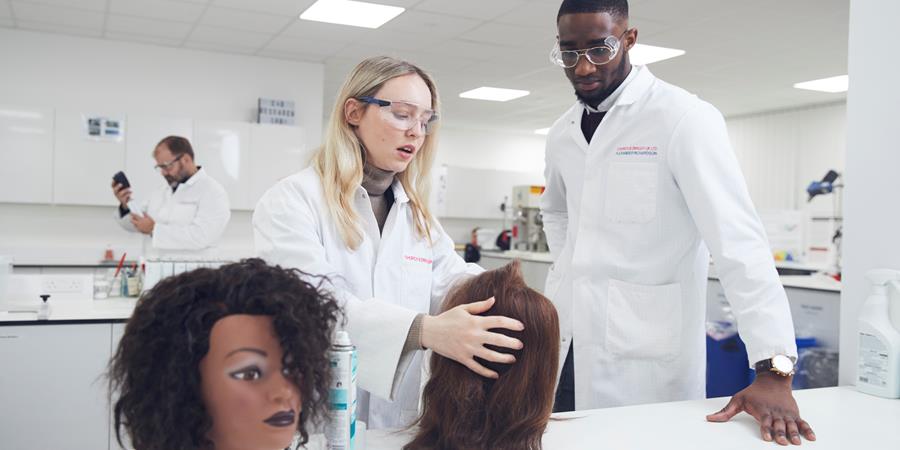
How to Get into Research and Development
24 Feb 2023
Share this post
By Church & Dwight
Research and Development
Each year, businesses in the United States collectively spend over half a trillion dollars on research and development (R&D). The federal government alone predicts a 9% increase in its R&D costs, and industry experts have noted how this upwards trajectory has led to R&D jobs becoming increasingly in demand .
With that in mind, many people are understandably researching how to work in research and development and aligning their career paths for a career in R&D experiments or R&D engineering.
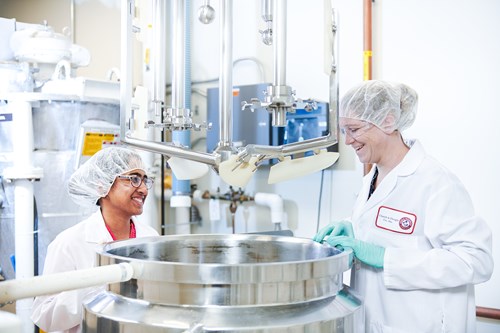
We’ve put together this article to offer an insight into securing a research and development job. However, before we address that directly, first it’s important to clarify the term.
Exactly what is research and development?
Research and development is the process which companies, institutions and even governments use to understand the market for their products and services, devise new ideas, and develop them to the point they can launch them as a professional offering. It can be broken down into two areas:
- Research is scientific in nature, focused on conducting experiments, analyzing results and drawing conclusions. This can happen in setting varying from labs, to focus groups, but either way the goal is to forensically understand the principles behind what works, what doesn’t, and where the opportunities for innovation lie.
- Development is about using that understanding to inform the creation of innovative new processes, products and services. The development phase uses a scientific approach but focuses on making a tangible end product, meaning that R&D engineering roles fall into this
If you’re a technically minded and detail-oriented professional with a passion to change the world and the drive to achieve amazing things under close scrutiny, a career in research and development could be for you.
What kind of R&D jobs are there?
Before setting out on a career in research and development, it’s important to understand the kinds
of roles available, so you can decide what best fits your skills and interests.
While the specific job titles may change from organization to organization, some of the most common R&D job types include:
- Scientists work in research and take time to understand problems and opportunities in the market
- Engineers work to solve a specific problem revealed by the scientist’s research
- Inventors are innovators who go a step further and create products designed to solve a problem in a way nobody has thought to
- Project managers oversee R&D projects, managing the budgets, timelines and milestones that the other team members work to.
How to get into a research and development career
Whatever area of the R&D industry you’re interested in, it pays to have a plan. Below, we’ll outline a general career path you can follow to help you pursue a rewarding R&D profession. Use these steps to help you along your journey.
1. Study a relevant degree
While the R&D field’s sheer vastness means there is no single, over-arching research and development degree, there are any number of relevant qualifications it might be relevant to study at the bachelor’s level and beyond.
R&D jobs tend to be complex, requiring a high level of technical ability and knowhow. For those with a general interest in R&D who are unsure which area they’ll want to go into, obtaining a degree in fields like computer science, mathematics or physics can help lead to a career in research and development. For those looking specifically into the engineering path, courses in aerospace, chemical, mechanical or electrical engineering can all prove to prospective employers that you have the acumen to begin a career in those fields. Managers meanwhile may come to a research and development job having pursued a degree in business administration, finance, or computer science.
2. Seek an entry level R&D job
Getting a degree in a related field is a great start because it shows prospective employers you are serious about your career path and have the acumen to go far in the R&D industry. Having said that, a career in research and development begins for real when you land an intern position. Thanks to
this post, you’re already armed with vital information about the general job roles you might investigate. To be more specific, entry-level R&D job titles you might come across include:
- Research and development assistant
- R&D associate
- Project management specialist
- Research analyst
- Entry-level scientist
- Junior global service engineer
- Entry-level chemist
- Packaging engineer
One great tip is to invest in researching your research and development job options with the same enthusiasm that you’d approach the career at large. Leave no stone unturned: study job postings, listen to podcasts, and speak to those with extensive R&D industry experience. When you’ve decided on the R&D job role(s) that interest you most, send resumes far and wide to land that all- important entry level role.
3. Continue adding to your qualifications
Obtaining a relevant research and development degree is only the beginning of what will prove a life-long learning journey in the R&D industry. Those looking to progress as engineers will want to pursue a Professional Engineering (PE) license, which is offered in different states by different licensing boards. You need at least four years of experience being supervised by a professional engineer in order to apply for a PE license, and you’ll also need to pass the Fundamentals of Engineering (FE) exam – so it’s no small order. Likewise, ongoing studies to obtain a Master’s degree or Doctorate can all help to significantly increase the salary you can command – and some companies may even offer to sponsor you if they feel a long and promising career in research and development lies ahead of you under their umbrella.
Different Types of Jobs in Research and Development
This post may have offered your first insight on how to get into research and development, but it really is just the beginning if you're just starting out and wanting to know more information. If you're wondering about the different roles available in the R&D industry then take a look at our blog post about exploring different jobs in the Research and Development industry .
Skills Required for Research and Development
Research & development roles require personal skills and attributes which make potential candidates successful at the jobs available in the field. Click here to learn more about some of the skills required for working in a research and development role.
Research and Development at Church and Dwight
To learn more about Research and Development at Church and Dwight, visit our R&D team page .
Looking to land your first R&D job – or maybe take your current R&D industry career the next level? Check out the R&D roles currently available here at Church & Dwight.
Related Articles
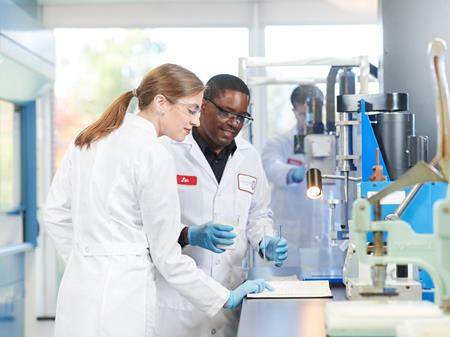
What Skills are Required for Research & Development?
30 Nov 2022

Exploring the Different Jobs in Research and Development
22 Feb 2023
MAKE AN IMPACT ON A GLOBAL SCALE
Find your place at Church & Dwight. We have locations around the world.
- WordPress.org
- Documentation
- Learn WordPress
Product Development Use Cases
Risks with product development, what product development engineers do, what are product development strategies, is product development part of r&d, why product development is necessary, is product development agile, product development key skills, stages to product development.

What Consists of a Research and Development Team?
What consists of a research and development team? Read on to learn more.
Research and Development Team
When you think of research and development teams, you may conjure up images of scientists in lab coats, working with beakers and test tubes, or at least that’s what others do.
Nothing could be further from the truth.
While there are some companies whose research and development team consists of most scientists, the vast majority are much more traditional business teams.
R&D teams can come from many different places.
They can be formed internally by the company, or they can be hired externally through an agency .
The former is much more common than the latter. However, there are situations where hiring an external company to handle research and development is beneficial for both parties.
Internal and External Research and Development Team
Internal R&D teams are often the best option. For one thing, the employees will already be familiar with the company’s products and services.
In addition, these existing employees are likely to be more motivated than an external R&D team.
The downside of this is that they will need to get training to meet the needs of the company, which can cost the company time and money.
However, this should not be a deal-breaker.
Hiring an external R&D team gives companies the advantage of bringing in fresh talent.
For example, if your company produces niche technology, you may need an R&D team with skills in that niche technology.
An external R&D team could bring in these niche-specific skills while at the same time providing you with their knowledge of existing technologies.
This could provide you with a huge competitive advantage.
It’s essential for research and development teams to feel that their contributions to the company receive value by upper management.
Therefore, it’s important that they’re involved in all major decisions regarding product development.
They should also receive their own set of metrics like other departments within your company. If they feel like they’re important to your company’s success, they’ll work harder to achieve their goals.
When companies create product development strategies, it is easy for them to fall into a single-track way of thinking because there is only one way to do something.
Research and development teams should challenge this thinking by proposing multiple ways to do whatever it is that they’re trying to do.
Then, encourage them to think outside of the box and propose multiple ways that you can take on a challenge or problem without being too risky or costly.
It may not always work out for you, but it might just pay off when it does.
Key takeaways
Research and development teams are critical to the success of a company.
They’re the ones who come up with new and innovative ways to improve existing products and services or to create entirely new and innovative products and services.
Make sure your company is prepared to deal with these teams.
Leverage the talents of your research and development teams by involving them in product development strategies and giving them metrics to help them succeed.
Leave a Reply Cancel reply
Your email address will not be published. Required fields are marked *
Save my name, email, and website in this browser for the next time I comment.

More Stories
Today, there are many reasons why product development is necessary. This is why companies need to do this process smartly....
Is product development agile? If not, how can you make it agile? What are the steps you need to do? To find...
Product Development Factors
What are some of the most important product development factors that you need to know? How can these help you...
Product Development KPI Metrics
Product development KPI metrics are important for companies to have. But what kinds of metrics should these be? And how...
Need for Product Development
Today, the need for product development is rising over time. That is why companies need to be more innovative with...
Why New Product Development Is Important
There are many reasons why new product development is important. These are the reasons why you need to do this process meticulously....
Recent Post
Top category, vp research and development.
- Research and Development (R&D) | Overview & Process
Featured in:

Companies often spend resources on certain investigative undertakings in an effort to make discoveries that can help develop new products or way of doing things or work towards enhancing pre-existing products or processes. These activities come under the Research and Development (R&D) umbrella.
R&D is an important means for achieving future growth and maintaining a relevant product in the market . There is a misconception that R&D is the domain of high tech technology firms or the big pharmaceutical companies. In fact, most established consumer goods companies dedicate a significant part of their resources towards developing new versions of products or improving existing designs . However, where most other firms may only spend less than 5 percent of their revenue on research, industries such as pharmaceutical, software or high technology products need to spend significantly given the nature of their products.
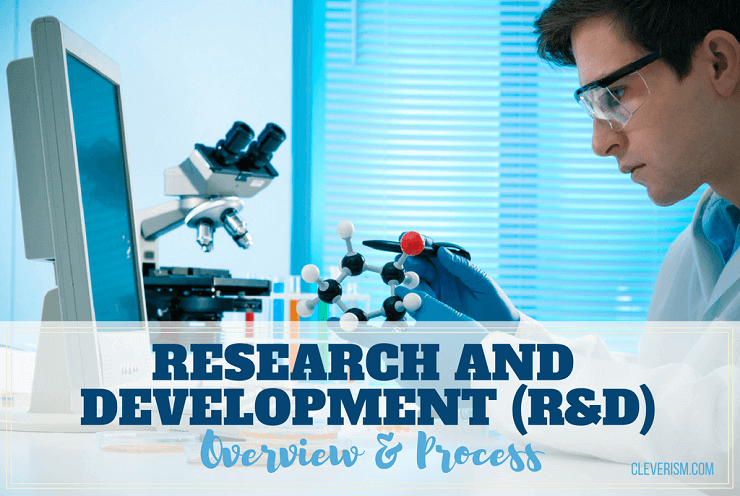
© Shutterstock.com | Alexander Raths
In this article, we look at 1) types of R&D , 2) understanding similar terminology , 3) making the R&D decision , 4) basic R&D process , 5) creating an effective R&D process , 6) advantages of R&D , and 7) R&D challenges .
TYPES OF R&D
A US government agency, the National Science Foundation defines three types of R&D .
Basic Research
When research aims to understand a subject matter more completely and build on the body of knowledge relating to it, then it falls in the basic research category. This research does not have much practical or commercial application. The findings of such research may often be of potential interest to a company
Applied Research
Applied research has more specific and directed objectives. This type of research aims to determine methods to address a specific customer/industry need or requirement. These investigations are all focused on specific commercial objectives regarding products or processes.
Development
Development is when findings of a research are utilized for the production of specific products including materials, systems and methods. Design and development of prototypes and processes are also part of this area. A vital differentiation at this point is between development and engineering or manufacturing. Development is research that generates requisite knowledge and designs for production and converts these into prototypes. Engineering is utilization of these plans and research to produce commercial products.
UNDERSTANDING SIMILAR TERMINOLOGY
There are a number of terms that are often used interchangeably. Thought there is often overlap in all of these processes, there still remains a considerable difference in what they represent. This is why it is important to understand these differences.
The creation of new body of knowledge about existing products or processes, or the creation of an entirely new product is called R&D. This is systematic creative work, and the resulting new knowledge is then used to formulate new materials or entire new products as well as to alter and improve existing ones
Innovation includes either of two events or a combination of both of them. These are either the exploitation of a new market opportunity or the development and subsequent marketing of a technical invention. A technical invention with no demand will not be an innovation.
New Product Development
This is a management or business term where there is some change in the appearance, materials or marketing of a product but no new invention. It is basically the conversion of a market need or opportunity into a new product or a product upgrade
When an idea is turned into information which can lead to a new product then it is called design. This term is interpreted differently from country to country and varies between analytical marketing approaches to a more creative process.
Product Design
Misleadingly thought of as the superficial appearance of a product, product design actually encompasses a lot more. It is a cross functional process that includes market research, technical research, design of a concept, prototype creation, final product creation and launch . Usually, this is the refinement of an existing product rather than a new product.
MAKING THE R&D DECISION
Investment in R&D can be extensive and a long term commitment. Often, the required knowledge already exists and can be acquired for a price. Before committing to investment in R&D, a company needs to analyze whether it makes more sense to produce their own knowledge base or acquire existing work. The influence of the following factors can help make this decision.
Proprietariness
If the nature of the research is such that it can be protected through patents or non-disclosure agreements , then this research becomes the sole property of the company undertaking it and becomes much more valuable. Patents can allow a company several years of a head start to maximize profits and cement its position in the market. This sort of situation justifies the cost of the R&D process. On the other hand, if the research cannot be protected, then it may be easily copied by a competitor with little or no monetary expense. In this case, it may be a good idea to acquire research.
Setting up a R&D wing only makes sense if the market growth rate is slow or relatively moderate. In a fast paced environment, competitors may rush ahead before research has been completed, making the entire process useless.
Because of its nature, R&D is not always a guaranteed success commercially. In this regard, it may be desirable to acquire the required research to convert it into necessary marketable products. There is significantly less risk in acquisition as there may be an opportunity to test the technology out before formally purchasing anything.
Considering the long term potential success of a product, acquiring technology is less risky but more costly than generating own research. This is because license fees or royalties may need to be paid and there may even be an arrangement that requires payments tied to sales figures and may continue for as long as the license period. There is also the danger of geographical limitations or other restrictive caveats. In addition, if the technology changes mid license, all the investment will become a sunk cost. Setting up R&D has its own costs associated with it. There needs to be massive initial investment that leads to negative cash flow for a long time. But it does protect the company from the rest of the limitations of acquiring research.
All these aspects need to be carefully assessed and a pros vs. cons assessment needs to be conducted before the make or buy decision is finalized.
BASIC R&D PROCESS
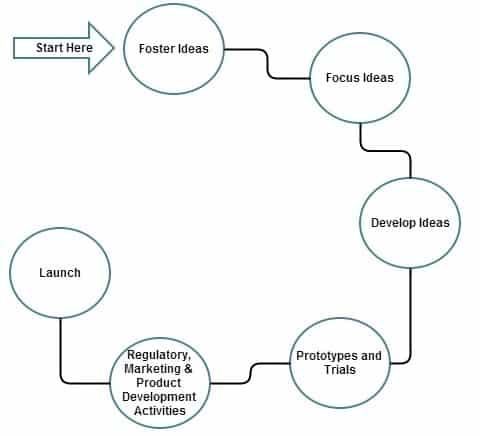
Foster Ideas
At this point the research team may sit down to brainstorm. The discussion may start with an understanding and itemization of the issues faced in their particular industry and then narrowed down to important or core areas of opportunity or concern.
Focus Ideas
The initial pool of ideas is vast and may be generic. The team will then sift through these and locate ideas with potential or those that do not have insurmountable limitations. At this point the team may look into existing products and assess how original a new idea is and how well it can be developed.
Develop Ideas
Once an idea has been thoroughly researched, it may be combined with a market survey to assess market readiness. Ideas with true potential are once again narrowed down and the process of turning research into a marketable commodity begins.
Prototypes and Trials
Researchers may work closely with product developers to understand and agree on how an idea may be turned into a practical product. As the process iterates, the prototype complexity may start to increase and issues such as mass production and sales tactics may begin to enter the process.
Regulatory, Marketing & Product Development Activities
As the product takes shape, the process that began with R&D divides into relevant areas necessary to bring the research product to the market. Regulatory aspects are assessed and work begins to meet all the criteria for approvals and launch. The marketing function begins developing strategies and preparing their materials while sales, pricing and distribution are also planned for.
The product that started as a research question will now be ready for its biggest test, the introduction to the market. The evaluation of the product continues at this stage and beyond, eventually leading to possible re-designs if needed. At any point in this process the idea may be abandoned. Its feasibility may be questioned or the research may not reveal what the business hoped for. It is therefore important to analyze each idea critically at every stage and not become emotionally invested in anything.
CREATING AN EFFECTIVE R&D PROCESS
A formal R&D function adds great value to any organization. It can significantly contribute towards organizational growth and sustained market share. However, all business may not have the necessary resources to set up such a function. In such cases, or in organizations where a formal R&D function is not really required, it is a good idea to foster an R&D mindset . When all employees are encouraged to think creatively and with a research oriented thought process, they all feel invested in the business and there will be the possibility of innovation and unique ideas and solutions. This mindset can be slowly inculcated within the company by following the steps mentioned below.
Assess Customer Needs
It is a good idea to regularly scan and assess the market and identify whether the company’s offering is doing well or if it is in trouble. If it is successful, encourage employees to identify reasons for success so that these can then be used as benchmarks or best practices. If the product is not doing well, then encourage teams to research reasons why. Perhaps a competitor is offering a better solution or perhaps the product cannot meet the customer’s needs effectively.
Identify Objectives
Allow your employees to see clearly what the business objectives are. The end goal for a commercial enterprise is to enhance profits. If this is the case, then all research the employees engage in should focus on reaching this goal while fulfilling a customer need.
Define and Design Processes
A definite project management process helps keep formal and informal research programs on schedule. Realistic goals and targets help focus the process and ensures that relevant and realistic timelines are decided upon.
Create a Team
A team may need to be created if a specific project is on the agenda. This team should be cross functional and will be able to work towards a specific goal in a systematic manner. If the surrounding organizational environment also has a research mindset then they will be better prepared and suited to assist the core team when ever needed.
Whenever needed, it may be a good idea to outsource research projects. Universities and specific research organizations can help achieve research objectives that may not be manageable within a limited organizational budget.
ADVANTAGES OF R&D
Though setting up an R&D function is not an easy task by any means, it has its unique advantages for the organization. These include the following.
Research and Development expenses are often tax deductible. This depends on the country of operations of course but a significant write-off can be a great way to offset large initial investments. But it is important to understand what kind of research activities are deductible and which ones are not. Generally, things like market research or an assessment of historical information are not deductible.
A company can use research to identify leaner and more cost effective means of manufacturing. This reduction in cost can either help provide a more reasonably priced product to the customer or increase the profit margin.
When an investor sets out to put their resources into any company, they tend to prefer those who can become market leaders and innovate constantly. An effective R&D function goes a long way in helping to achieve these objectives for a company. Investors see this as a proactive approach to business and they may end up financing the costs associated with maintaining this R&D function.
Recruitment
Top talent is also attracted to innovative companies doing exciting things. With a successful Research and Development function, qualified candidates will be excited to join the company.
Through R&D based developments, companies can acquire patents for their products. These can help them gain market advantage and cement their position in the industry. This one time product development can lead to long term profits.
R&D CHALLENGES
R&D also has many challenges associated with it. These may include the following.
Initial setup costs as well as continued investment are necessary to keep research work cutting edge and relevant. Not all companies may find it feasible to continue this expenditure.
Increased Timescales
Once a commitment to R&D is made, it may take many years for the actual product to reach the market and a number of years will be filled with no return on continued heavy investment.
Uncertain Results
Not all research that is undertaken yields results. Many ideas and solutions are scrapped midway and work has to start from the beginning.
Market Conditions
There is always the danger that a significant new invention or innovation will render years of research obsolete and create setbacks in the industry with competitors becoming front runners for the customer’s business.
It is important for any business to understand the advantages and disadvantages of engaging in Research and Development activities. Once these are studied, then the step can be taken towards becoming and R&D organization.
In the meanwhile, it is good practice to inculcate a research mind set and research oriented thinking within all employees, no matter what their functional area of expertise. This will help bring about new ideas, new solutions and an innovative way of approaching all business problems, whether small or large.
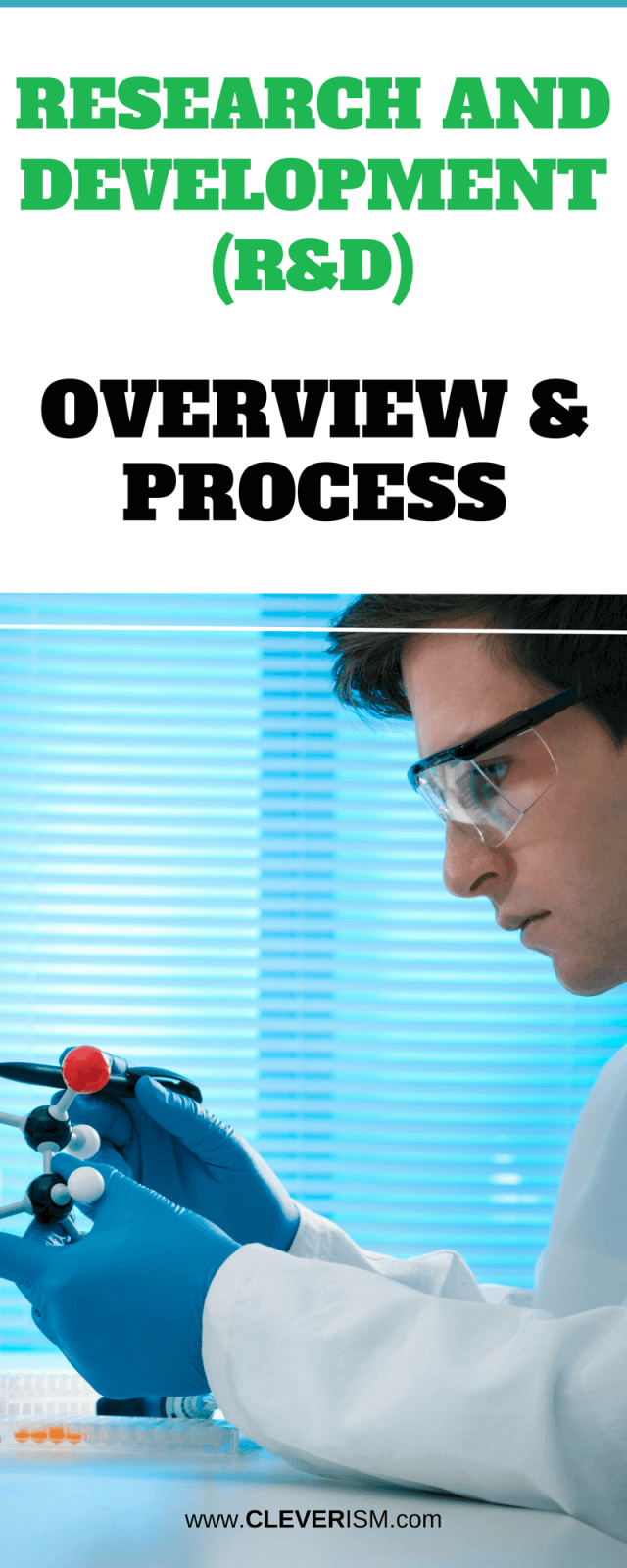
Comments are closed.
Related posts
When Should Companies Split: An Analysis of Ebay and Paypal Split
Every day, there seems to be a constant stream of companies opening their doors and businesses …
How To Use The Hook Model For Building Great Products
The market is filled with so many products, but not all of them are considered to be great, or even …
Why Disruption is Coming for Your Industry – And How to Embrace It
Are you ready for the disruption coming to your industry? If you are an established business that …
408,000 + job opportunities

Not yet a member? Sign Up
join cleverism
Find your dream job. Get on promotion fasstrack and increase tour lifetime salary.
Post your jobs & get access to millions of ambitious, well-educated talents that are going the extra mile.
First name*
Company name*
Company Website*
E-mail (work)*
Login or Register
Password reset instructions will be sent to your E-mail.
Everything that you need to know to start your own business. From business ideas to researching the competition.
Practical and real-world advice on how to run your business — from managing employees to keeping the books.
Our best expert advice on how to grow your business — from attracting new customers to keeping existing customers happy and having the capital to do it.
Entrepreneurs and industry leaders share their best advice on how to take your company to the next level.
- Business Ideas
- Human Resources
- Business Financing
- Growth Studio
- Ask the Board
Looking for your local chamber?
Interested in partnering with us?
Start » strategy, what is research and development .
Research and development provides businesses with the information they need to successfully bring their products or services to market.

In any industry, even the most revolutionary products and services are rarely fully conceptualized on day 1. Most often, success in the market stems from extensive, effective research and development (R&D). This is especially true for small businesses, which contribute a significantly higher percentage of sales to R&D work than larger businesses.
Here’s everything you need to know about R&D and why it’s well worth the investment.
What is research and development?
R&D refers to the various activities businesses conduct to prepare new products or services for the marketplace. Businesses of all sizes and sectors can partake in R&D activities, though the amount of investment can vary. For example, technology and health care companies tend to have higher R&D expenses , as do enterprises with larger budgets.
Typically the first step in the development process, R&D is not expected to yield immediate profits. Rather, it focuses on innovation and setting up a company for long-term profitability. During this process, businesses may secure patents, copyrights, and other intellectual property associated with their products and services.
At larger companies, R&D activities are often handled in-house by a designated R&D department. However, some smaller companies may opt to outsource R&D to a third-party research firm, a specialist, or an educational institution.
[Read more: 7 Ways to Find Small Business Grant Opportunities ]
Types of research and development
R&D activities typically fall into one of three main categories:
- Basic research: Basic research, sometimes called fundamental research, aims to provide theoretical insight into specific problems or phenomena. For example, a company looking to develop a new toy for children might conduct basic research into child play development.
- Applied research: This type of research is practical and conducted with a specific goal in mind, most often discovering new solutions for existing problems. The children’s toy company from the previous example might conduct applied research into developing a toy that facilitates play development in a new or improved way.
- Development research: In development research, researchers focus exclusively on applied research to develop new products and improve existing ones. For example, a team of development researchers may test the hypothetical company’s new toy or implement feedback obtained from customers.
Small businesses have limited resources. They don’t have that endless budget that the Fortune 500 company has, which means the small business will have to get creative to conduct worthwhile research and development.
Becca Hoeft, CEO and Founder of Morris Hoeft Group
Why invest in research and development?
While R&D can require a significant investment, it also yields several advantages. Below are four specific areas where your business can benefit by conducting R&D.
New products
R&D supports businesses in developing new offerings or improving existing ones based on market demand. By conducting research and applying your findings to your final product, companies are more likely to develop something that meets customers’ needs and performs well in the marketplace.
R&D can help businesses understand their place in the market as well as identify inefficiencies in their workflows. Insights from R&D activities can illuminate ways to improve operations as well as where to most effectively allocate resources, increasing overall efficiency.
Cost reductions
While developing a well-researched product or service that performs well is likely to maximize profit, R&D aimed at improving internal processes and technologies can reduce the cost of bringing products and services to market.
Businesses that invest in R&D may be eligible for specific tax incentives. For one, the federal R&D tax credit offers a dollar-for-dollar reduction in tax liability for businesses that partake in various research-based activities. Eligible companies can apply for this credit by submitting Form 6765 with their business taxes.
[Read more: How to Seek Funding for Your Invention ]
Overcoming the challenges of small business R&D
According to Becca Hoeft, CEO and Founder of Morris Hoeft Group , small businesses may face numerous challenges related to R&D that their larger counterparts might not experience.
“Small businesses have limited resources,” said Hoeft. “They don’t have that endless budget that the Fortune 500 company has, which means the small business will have to get creative to conduct worthwhile research and development.”
While R&D funding is available through various government grants, university programs, and research institutions, Hoeft noted that it may take some time and strategic planning to obtain it. She recommended that small business owners start talking publicly about what kind of research they are doing and what they need to conduct it.
“Don’t hide under a rock and expect money to magically appear,” Hoeft told CO—. “Get on a stage at a relevant conference [or] start a blog series about your idea.”
Keep in mind that once you start sharing your ideas and what you want to research, “it’s out there in the universe,” said Hoeft. Therefore, protecting your intellectual property before you begin and during the research process is extremely important.
“Ensure your trademarks, patents, and copyrights are in place to protect you and your small business,” Hoeft added.
[Read more: How to Qualify for and Claim the R&D Tax Credit ]
CO— aims to bring you inspiration from leading respected experts. However, before making any business decision, you should consult a professional who can advise you based on your individual situation.
CO—is committed to helping you start, run and grow your small business. Learn more about the benefits of small business membership in the U.S. Chamber of Commerce, here .

Subscribe to our newsletter, Midnight Oil
Expert business advice, news, and trends, delivered weekly
By signing up you agree to the CO— Privacy Policy. You can opt out anytime.
For more business strategies
How to partner with a university as a small business, 9 steps to creating a procurement process for your small business, how to file a beneficial ownership information report for your business.
By continuing on our website, you agree to our use of cookies for statistical and personalisation purposes. Know More
Welcome to CO—
Designed for business owners, CO— is a site that connects like minds and delivers actionable insights for next-level growth.
U.S. Chamber of Commerce 1615 H Street, NW Washington, DC 20062
Social links
Looking for local chamber, stay in touch.
- 800-232-LOWE (5693)
- [email protected]
- 58220 Decatur Road Cassopolis, MI 49031
Managing Innovation and R&D
Digital library > defining and serving a market > product development, “managing innovation and r&d”.
No company wants to stagnate, no matter how good business might be today. Get ideas on how to stimulate your R&D team into the right creative groove, without wasting time on unprofitable ventures.
An effective research and development team — one that produces innovative ideas, revenue-generating products, service packages and methods — is crucial to any emerging-growth business. Yet it takes a combination of elements and a different approach by business leaders to foster a team that will consistently push innovation. It isn’t always expensive or even time-consuming to create innovative ideas, but it does require innovative leadership.
In this Quick-Read you will find:
SOLUTION [ top ]
To create innovative production methods, products or service strategies you must have innovative thinkers. Often, corporate structure stifles creativity in the workplace by rewarding conformity over creativity. Mistakes are viewed as expensive liabilities often threatening our jobs.
Yet an innovative, productive R&D department is one that is allowed to work with a certain degree of autonomy. Failures are celebrated, not condemned. Collaboration, sometimes even with the competition, is encouraged; and the value of knowledge and process outweigh concerns about the bottom line.
Management methods to develop and encourage a productive R&D team
Three tips to determine when to invest in R&D
Team-building tips
You’ve answered the strategic questions, created room in the budget, now who will do the research? Do you have an internal department or creative staff members, or should you hire outside contractors?
If the project is a long-term process, such as developing a new technology or platform, which could take years, develop an internal team of inventors and have them seek outside contractors at various times in the process. Free your researchers from other work, don’t limit their role by job description or tight corporate rules. Set up a management structure that offers autonomy to explore and experiment.
If hiring an outside contractor, assess whether the company is stable; check references, and make sure its work processes are compatible. Then discuss goals and management. Who will control the process and the time line? Set up a management structure and implement a broad nondisclosure clause to limit some of the confidentiality risks. Remember the key to innovation is collaboration and the sharing of accumulative expertise from other scientists.
REAL-LIFE EXAMPLE [ top ]
Research and development is key to the success of GoAhead Software, a firm in Bellevue, Wash., that makes SelfReliant products, a line of service availability software. CEO Michael O’Brien describes the product line as "an immune system" in the computer that keeps the Internet and the wireless infrastructure up and running for manufacturers, including Intel and Motorola.
To cost-effectively stimulate creativity in R&D, O’Brien and his team use the "spiral development model," a process in which much of the R&D happens in front of prospective customers.
"You can use the classic waterfall development model where you have a product concept, develop all the requirements, design it, implement it, test and ship it," O’Brien says. "But if you’re in a new market that needs a lot of creativity, sometimes that doesn’t work. You have to get requirements right with far less validation. If something’s not quite right, you have to invest more time and more money [to fix it]."
That’s where the spiral model, which GoAhead used for its SelfReliant products, comes in. First, the R&D team develops a concept, th en creates a presentation that gives a feel for what the product will do. Next, they take that to "one of your least damaging customers" for a reaction. "Say, ‘If we build this would you be interested?’ They’ll either say ‘Great!’ or ‘It would be good if it was like this.’ You’ll get valuable information," O’Brien says.
Based on client input, the team revises the product and takes it to the next client and then the next, spiraling up until there is a fine-tuned product to present to one of the company’s most important prospects. "You’re developing ideas in sync with your customers. We get one or two gems from no matter who it is on the spiral," O’Brien reports. "You have to invest, but it stops you from going down the road blind. It’s very effective because you’re working with the best in the industry and getting their requirements." You’re also building likely buyers because you’re including input from each customer in the final design, O’Brien notes.
DO IT [ top ]
RESOURCES [ top ]
The Smart Organization: Creating Value Through Strategic R&D by David Matheson and Jim Matheson (Harvard Business School, 1998).
Achieving Planned Innovation: A Proven System for Creating Successful New Products and Services , 3rd edition, by Frank R. Bacon and Thomas W. Butler (Free Press, 1998).
" Going for Broke " by Edward O. Welles, Inc. magazine, June 1998. A cautionary tale illustrating the risk of letting R&D become more important than business. "The R&D Trap" sidebar near the end of the lengthy article offers advice on R&D budget control.
" Failure Is An Option " by Pat Dillon, Fast Company, February/March 1999. Another cautionary tale of an R&D company that developed one big product whose market disappeared.
" Managing Innovation in Product Development: An Entrepreneurs’ Guide " by Steven Gordon, EntreWorld.org, October 1997.
" Getting It Done " by Paul Roberts, Fast Company, June 2000.
" Technology: What We Do ." Description of the U.S. Small Business Administration’s Small Business Innovation Research and Small Business Technology Transfer programs, which link companies to government agencies that will fund R&D projects to develop products in their fields of interest.
Article Contributors
Writer: Polly Campbell and Kathy Furore
Consultants: Russ George, owner of Ocean Carbon Sciences Inc. and a scientist, inventor and research and development contractor, was interviewed for this article.
JOIN SOMEKA BUSINESS: Subscribe to Business Membership for exclusive benefits! Dismiss
26 Most Important R&D KPIs and Metrics
- Updated on July 13, 2023
If you want to accurately measure your Research and Development performance but don’t where to start, we collected all the necessary R&D KPIs and metrics for you!
Also, we are proud to present our R&D Dashboard templates if you need to make the analysis and recording within you Research and Development department. But first, you can learn more about the R&D key metrics!
What is KPI in research and development?
Research and development KPIs or key performance indicators are used to determine the performance of research and development departments in businesses.
Why should you track r&d KPIs?
You should track research and development key metrics to have a clear point of view about the state of your R&D department. That way, you can improve and anvance your R&D department in an organized manner.
What are the most important KPIs in r&d?
Research and development departments deal with different issues in each other company, so there are various metrics you can use. However, you can see the top 26 research and development KPIs below to get a better idea.
Research and Development Metrics

1. Proposal Success Rate
R&D Metrics / Project Progress / Work Effectiveness
Description: Percentage of grant applications that successfully received funding and can go further with the R&D.
Calculation Method / Formula: number of applications that were accepted and got funds / number of all applications
Should be High or Low?: The higher % the better. Otherwise there is needed extra work time on creating or redefining ideas.
2. Ideas turned into experiments
Description: This shows of how many ideas within some period of time went into the experimental phase. It depends on how many ideas there is; has granted funds and if the R&D team is managing the time given properly.
Calculation Method / Formula: number of ideas within some period of time went into the experimental phase / number of ideas that were supposed to be in the experimental phase within specified period of time
Should be High or Low?: If the % is going down it may indicate not enough resources in people or equipment.
3. Projects completed
R&D Metrics / Project Progress / Work Effectiveness / Time Management
Description: Shows the ratio of completed within all started projects. But in case there are some changes, or the grant funds are frozen or for some other seasons the project cannot continue it can have influence on the completion ratio. This metrics allows you to track if you have enough resources and capability to open more tasks and manage to stay on time with the work planned.
Calculation Method / Formula: completed projects / all planned projects
Should be High or Low?: If the % is going down it may indicate not enough resources in people or equipment or some changes in a project or requirement that may close the project not completed.
4. Time-to-market
Description: This metrics stands for how quickly your company plan and execute the projects. It is the duration from Phase 0 to Market Release. Average number of days per project
Calculation Method / Formula: It can be calculated as simple average: Cumulative number of days of all finished projects / number of projects
Should be High or Low?: If the time to market exceed planned days, it can give some indication about incorrect assumptions or some unexpected problems
5. Time for the experiments
Description: This is metrics shows time spent only for the experiment phase. That time can be very different depending on a sector of the R&D department. The unit of time may be measured in Days as default, but it can be also adjusted for your needs.
Calculation Method / Formula: cumulative experimental time of number of projects / number of projects
Should be High or Low?: If the time goes over a target this may indicate problems that weren’t predicted in the planning phase.
6. Deviation from Schedule
Description: This metrics measures how accurate planned project schedules are. And may indicate if there is some need for changing the system of planning or find some bottleneck of the process.
Calculation Method / Formula: (Actual Time to Make – Planned Time to make) / Planned Time to Make.
Should be High or Low?: Based on the equation if the value is below zero it means the projects’ time are overcalculated and probably the time evaluation should be restructured. The same if the value goes above zero but it means the predicted time probably was too small for the available resources.
7. Portfolio in existing products
R&D Metrics / Product Investment / Budget Management
Description: Percentage of R&D Budget which keep the existing products.
Calculation Method / Formula: Cost of sustaining the exisiting products / total R&D budget
8. R&D costs / Total costs
R&D Metrics / Product Investment / Budget Management / Cost
Description: This metrics shows what is the percentage of exactly the R&D cost among Total Costs of the R&D department. (or among total cost of the company)?
Calculation Method / Formula: R&D cost / Total cost of R&D dept.
Should be High or Low?: This is just an orientation information.
9. License costs / Total R&D cost
Description: Shows how big part of Total costs is License Costs.
Calculation Method / Formula: Licence cost / Total cost od R&D dept.
10. R&D Costs / Sales
R&D Metrics / Product Investment / Budget Management / Cost / Sales / Performance
Description: It shows the ratio between money spend on R&D and the money earned from Total Sales
Calculation Method / Formula: Total R&D cost / Total sales
Should be High or Low?: First of all, R&D cost should not be higher than total sales, but also the higher difference there will be the higher profit will be observed
11. Product improvements / R&D cost
Description: Shows how big part of R&D costs is Product Improvements.
Calculation Method / Formula: Improvement Costs / R&D Costs
Should be High or Low?: This is an orientation information. There might be some target to reduce that cost, but it depends on the characteristics of R&D projects.
12. Cost Savings Attributable to R&D
R&D Metrics / Product Investment / Budget Management / Cost / Savings
Description: This metrics helps to calculate the cost savings because of the R&D Department’s improvements. Cost savings in given period of time.
Calculation Method / Formula: Might be calculated by (time needed to compleete some task before – time needed after improvenents) * workinghour cost in some period of time
Should be High or Low?: Based on that measurement we can measure how long it will take to “pay back” the cost of improvement.
13. Total Patents Filed
R&D Metrics / Cost / R&D Investment / Product Investment / Brand Value
Description: This metrics shows the number of patents waiting to be approved by the patent institution.
Should be High or Low?: If the patents are unique or it is predicted that they will bring income higher than cost of keeping patent itself then the higher number is better but the target should be set based on how much valuable they can be.
14. Ideas in the Pipeline
Description: It helps to track the number of ideas that were completed and put in a schedule in an assumed time or period.
Should be High or Low?: Target depends on the R&D sector and taken period of time.
15. Projects that meet planned targets
Description: It helps to track the number of projects which follow to the plan schedule in each time or period.
16. Products launched on time
Description: This metrics shows how many projects were completed and launched out of the planned to be completed in that given period.
Calculation Method / Formula: number of projects completed / number of sheduled projects to be completed
Should be High or Low?: If the % is much lower the assumption in scheduling should be checked.
17. Number of products released
R&D Metrics / Work Effectiveness / Products / Brand Value
Description: Shows how many products were released in a given time.
Should be High or Low?: Target depends on the R&D sector, time and value per product.
18. Income from New products
R&D Metrics / Products / Revenue / Sales / Profitability
Description: New products (which might not be yet noticed by all the target customers) sales value among total sales in percentage.
Calculation Method / Formula: new product sales value / total incom from all product sales
Should be High or Low?: It can help to plan in future some steps to make the product more visible from the beginning.
19. Budget Variance / Cost Variance (CV)
R&D Metrics / Budget Management / Financial Performance / Revenue / Cost
Description: This metrics shows how accurate is your planning the project costs and how well you manage the budget during the time of project life from the beginning until Market Release. The percentage in the end of project shows what is the percentage of assumed at the beginning cost. If the value comes close to zero long before the end of the project it may show that the budget evaluation was wrong.
Calculation Method / Formula: Earned Value – Actual Cost
Should be High or Low?: If the conclusion is: below 0 – you are behind the schedule; 0 – you are on schedule; above zero – ahead of schedule.
20. Return on Innovation Investment (ROI)
R&D Metrics / Revenue / Budget Management / Financial Performance / Investment
Description: This metrics can help to predict if the investment in the new product was worth the cost and how long it might take for money return.
Calculation Method / Formula: ( Profits of New Product or Service Sales) / (Expenditures Generated in Creating these New Products or Services)
21. Products launched on budget
R&D Metrics / Budget Management / Product Investment / Work Efficiency
Description: This metrics shows percentage of new services or products that has been finished within expected budget. It shows how accurate is the cost projection.
Should be High or Low?: If the metrics should be as close as possible to 100%, if it is much lower it may indicate wrong budget planning or lots of unexpected changes that were not included in the calculations.
22. Research & Development Effectiveness Index (RDEI)
R&D Metrics / Work Efficiency / Revenue / R&D Investment / Profitability
Description: It shows how the profit generated by new products compares to total R&D expenses. Success of product vs development efforts.
Calculation Method / Formula: Profit from New Products / R&D Sending
23. Total R&D Headcount
R&D Metrics / Employee Management / Budget Management
Description: Number of employees in the R&D department.
Should be High or Low?: The target should be based on projections and which direction company is going, what is the budget for hiring.
24. Portfolio in Core and Growth Projects
R&D Metrics / Project Progress / Work Effectiveness / Cost
Description: This metrics is the percentage of Projects that will not be completed even though company has already invested in them.
Should be High or Low?: It will have strong negative or positive impact on the growth and prosperity of the company.
25. R&D Budget
R&D Metrics / Budget Management / R&D Investment / Cost
Description: This metrics is the budget of the company intended for the R&D Department.
Should be High or Low?: May depend on the target and the direction of the company.
26. Suggested ideas by the team
R&D Metrics / Work Effectiveness / Product Investment
Description: That is a number of ideas which the R&D Department came up with during some period of time.
Should be High or Low?: In general, the more ideas the better, but the quality of ideas has an impact on further work and eventual success.
Below is the summary of R&D KPI metrics:
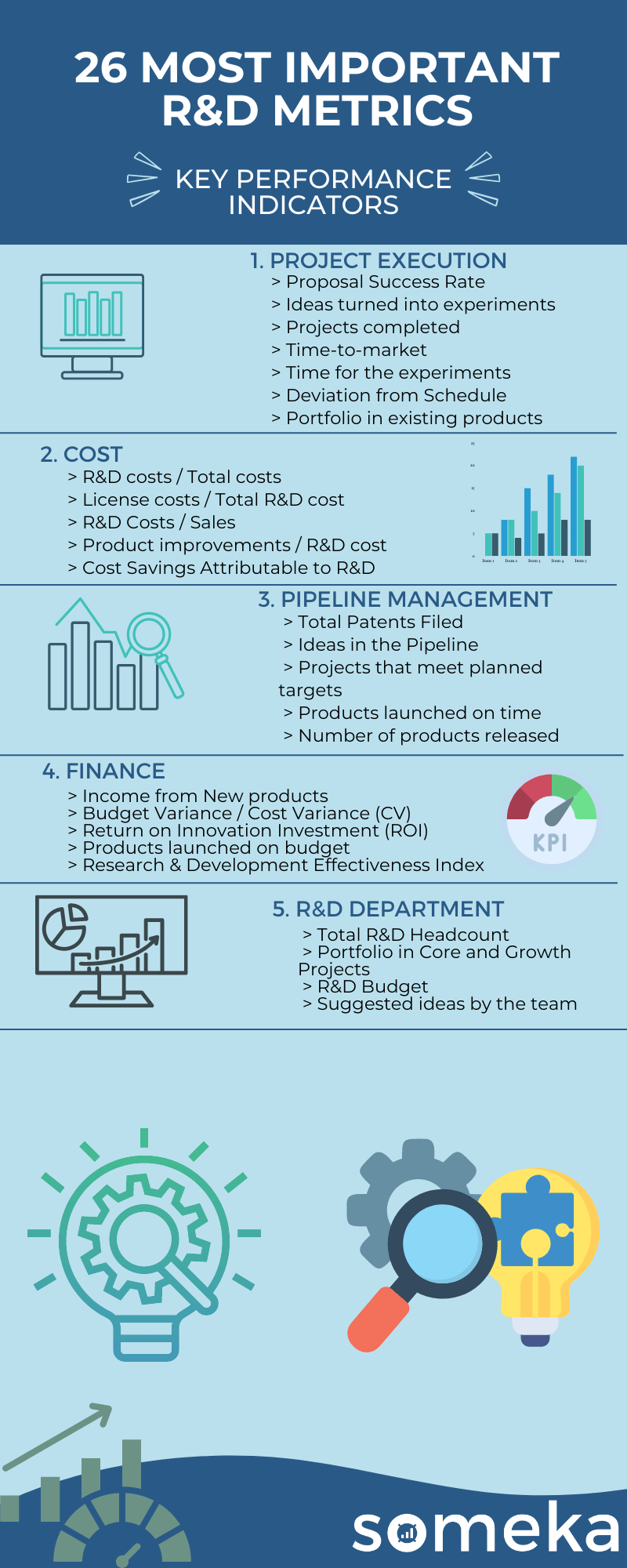
Most Important KPIs for Different Industries
If you are interested in other industries or departments and their performance, you should learn more about their KPIs via our related articles!
Related Posts

- Search Search Please fill out this field.
- Investing in R&D
- What R&D Offers
- The R&D Tax Credit
Buyouts and Mergers
- R&D Benefits
The Bottom Line
- Business Essentials
Why You Should Invest in Research and Development (R&D)
:max_bytes(150000):strip_icc():format(webp)/picture-53893-1440688982-5bfc2a88c9e77c005143c705.png)
Research and development (R&D) is the part of a company's operations that seeks knowledge to develop, design, and enhance its products, services, technologies, or processes. Along with creating new products and adding features to old ones, investing in research and development connects various parts of a company's strategy and business plan.
According to the latest Business Enterprise Research and Development survey by the National Center for Science and Engineering and the U.S. Census Bureau, businesses spent $32.5 billion to support their R&D activities in 2020.
Here are some reasons your business should invest in research and development.
Key Takeaways
- Research and development (R&D) is an essential driver of economic growth as it spurs innovation, invention, and progress.
- R&D spending can lead to breakthroughs that can drive profits and well-being for consumers.
- Today, R&D is present in nearly every business sector as companies jockey for position in their respective markets.
- Smaller firms engaged in R&D can offset some of these costs and attract investors thanks to a federal tax break.
Investing in Research and Development (R&D)
The Internal Revenue Service's definition of research and development is investigative activities that a person or business chooses to do with the desired result of a discovery that will create an entirely new product, product line, or service.
However, the activities don't only need to be for disovering new products or services—this is only for tax purposes.
R&D isn’t just about creating new products; it can be used to strengthen an existing product or service with additional features.
Research refers to any new science or thinking that will result in a new product or new features for an existing product. Research can be broken down into either basic research or applied research. Basic research seeks to delve into scientific principles from an academic standpoint, while applied research aims to use that basic research in a real-world setting.
The development portion refers to the actual application of the new science or thinking so that a new or increasingly better product or service can begin to take shape.
Research and development is essentially the first step in developing a new product, but product development is not exclusively research and development. An offshoot of R&D, product development can refer to the entire product life cycle , from conception to sale to renovation to retirement.
R&D Offers Productivity, Product Differentiation
Firms gain a competitive advantage by performing in some way that their rivals cannot easily replicate. If R&D efforts lead to an improved type of business process—cutting marginal costs or increasing marginal productivity—it is easier to outpace competitors.
R&D often leads to a new type of product or service—for example, without research and development, cell phones or other mobile devices would never have been created. The internet, and even how people live today, would be completely different if businesses had not conducted R&D in the past.
Research results give businesses a means to find issues people have and ways to address them, and development allows companies to find unique and different ways to fix the problems.
This leads to many different product and service variations, which gives consumers choices and keeps the markets competitive. Some examples of companies that carry out R&D activities are auto manufacturers, software creators, cutting-edge tech companies, and pharmaceutical firms.
The R&D Tax Credit
In 1981, the IRS started offering tax breaks for companies to spend money and hire employees for research and development. Qualifying companies include startups and other small ventures with qualified research expenses. Such expenses can be used to offset tax liabilities , along with an impressive 20-year carry-forward provision for the credit.
Many entrepreneurs and small businesses have made a large sum of money in a short time by selling good ideas to established firms with many resources. Buyouts are particularly common with online companies, but they can be seen wherever there is a lot of incentive to innovate.
Research and development can help your ideas or business become more attractive to investors and other companies looking to expand.
Advertising and Marketing R&D Benefits
Advertising is full of claims about revolutionary new techniques or never-before-seen products and technologies. Consumers demand new and improved products, sometimes simply because they are new. R&D departments can act as advertising wings in the right market.
R&D strategies let companies create highly effective marketing strategies around releasing a new or existing product with new features. A company can create marketing campaigns to match innovative products and market participation.
What Are the Reasons for R&D?
Research and development keep your business competitive. Without R&D, you risk losing your competitive advantage and falling behind other companies researching and developing new products in your industry.
Why Is R&D Important for Startups?
R&D is essential because it helps you keep your business momentum going. New products and services help you attract more customers, make sales, and give you something to talk about with your investors.
What Factors are Essential in Successful R&D?
Successful research and development depend on many factors, but the most important is a strong interest from your customer base and investors. If you spend money and time researching and developing something no one wants, it's being wasted.
Increased market participation, cost management benefits, advancements in marketing abilities, and trend-matching are all reasons companies invest in R&D. R&D can help a company follow or stay ahead of market trends and keep the company relevant.
Although resources must be allocated to R&D, the innovations gained through this research can actually work to reduce costs through more efficient production processes or more efficient products. R&D efforts can also reduce corporate income tax, thanks to the deductions and credits they generate.
National Center for Science and Engineering. " Businesses Invested $32.5 Billion in Assets to Support Their R&D Activities in the United States in 2020 ."
Tax Foundation. " Reviewing the Federal Tax Treatment of Research & Development Expenses ."
Internal Revenue Service. " About Form 6765, Credit for Increasing Research Activities ."
Internal Revenue Service. " Instructions for Form 3800 (2022) ," Page 2.
:max_bytes(150000):strip_icc():format(webp)/randd.asp-fb436cb94bed4c8a8032f732887153db.jpg)
- Terms of Service
- Editorial Policy
- Privacy Policy
- Your Privacy Choices
The New York Times Research and Development team applies emerging technologies in service of our company’s mission to seek the truth and help people understand the world.
Using new technologies and formats, we develop technical capabilities for our newsroom and new forms of storytelling for our readers. As part of our method, we evaluate emerging trends in media and technology and forecast how they might play out over the next two to three years. Once we identify an opportunity, we dedicate a team to exploring the space and developing products in collaboration with other parts of our organization.
We're a multidisciplinary team of journalists, creative technologists, designers and engineers. We're always looking for smart people who want to work on interesting problems, as well as commercial and academic collaborators. If you are interested in working together, check out our Jobs page or reach out to [email protected] .
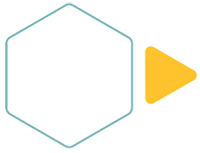
Georgia AIM welcomes new managing director for industry partnerships
Mar 15, 2024 —.
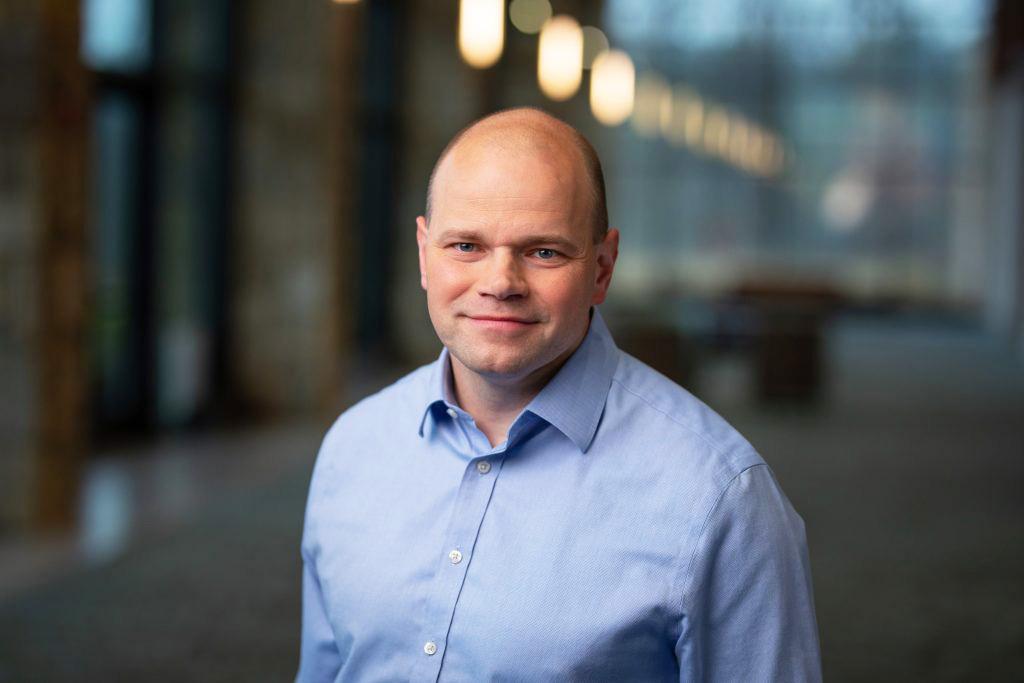
Steven Ferguson , principal research scientist with the Georgia Tech Manufacturing Institute, named managing director of the Georgia Artificial Intelligence in Manufacturing (Georgia AIM) leadership team.
A new member of the Georgia Artificial Intelligence in Manufacturing ( Georgia AIM ) leadership team will serve as a key connector between industry and Georgia AIM innovations and workforce development programs.
Steven Ferguson, who begins March 16 as a principal research scientist with the Georgia Tech Manufacturing Institute , comes to Georgia AIM from the Technical College System of Georgia (TCSG). In his previous role, Ferguson served as chief information officer, where he led information technology, research, innovation, and data enterprises across Georgia’s technical colleges.
Now, Ferguson will leverage his experience working in technical education and workforce development to connect with Georgia companies. In this new role, he will also be the executive director of the Georgia Tech Manufacturing 4.0 Consortium . This new collaborative within Georgia AIM gives manufacturers exclusive access to emerging technologies at Georgia Tech’s Advanced Manufacturing Pilot Facility .
“I’m excited to join the team at Georgia Tech as I will get to work extremely close with both manufacturers and the research community,” said Ferguson. “For years, I’ve helped translate knowledge gained through research into hands-on training for the workforce. Now, I get to dedicate my time to that — I’m committed to working hand-in-hand to bridge the knowledge gap and get cutting-edge technology to Georgia’s manufacturers.”
Ferguson said one of his passions is serving the incumbent workforce — specifically, employees who have significant on-the-job experience. This will be key in his new role with the Manufacturing 4.0 Consortium, Ferguson said, as he can work closely with manufacturers to better understand their current and future workforce needs.
Addressing gaps in the workforce is also a main goal for Georgia AIM, which is working to connect artificial intelligence to manufacturers across the state. Automation, collaborative robots, sensors, and data collection are all part of smart technologies revolutionizing manufacturing. But a trained workforce is essential in order to implement these changes.
After a long and successful career with TCSG, Ferguson said he is eager to tackle the challenges and opportunities that lie ahead with Georgia AIM.
“To truly integrate AI technology into manufacturing, we need to ensure that the incumbent workforce is not just familiar but comfortable with these advancements,” he said. “While manufacturing inherently focuses on production, our aim is to make technology a fundamental aspect of this sector’s growth and evolution.”
View the story on Georgia AIM's website >>

- Current Article
Scramjet prototype tests Purdue hypersonics additive-manufacturing capabilities
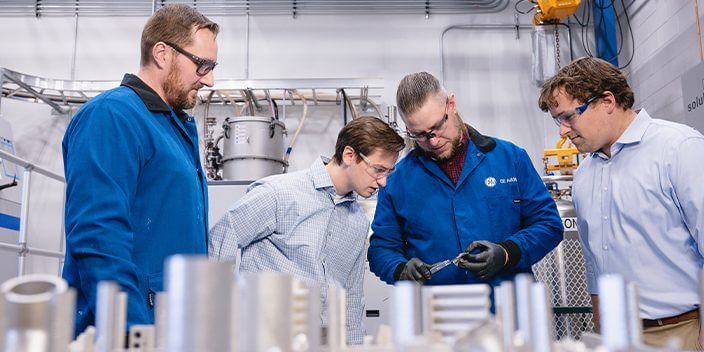
WEST LAFAYETTE, Ind. — A team at the Purdue Applied Research Institute (PARI) , the university’s research and development center, is using state-of-the-art additive-manufacturing equipment to print a full-scale, fully operational prototype of a supersonic combustion ramjet, or scramjet, an engine that allows aircraft to travel at speeds of Mach 5 and beyond.
Researchers in PARI’s Hypersonic Advanced Manufacturing Technology Center (HAMTC) believe this innovative scramjet design paves the way for more affordable and expedient prototyping and manufacturing processes across the hypersonics industry.
“There’s no other university-affiliated institution with the capability to manufacture and then test hypersonic technologies at flight-relevant scales and conditions,” said graduate research assistant Will DeVerter, who created the full-scale scramjet prototype with senior test engineer Nick Strahan. “Once we have a part or system ready to go, I can walk it across the street and test it using some of the best propulsion and diagnostic technology in the world. That’s a unique capability that streamlines the entire manufacturing and testing process.”
Strahan likened scramjet functionality to trying to light a candle in a hurricane. “You have to sustain a flame in air speeds in excess of Mach 2, so the technological challenge is creating a combustor that can operate efficiently and burn fuel with air traveling at really high velocities,” Strahan said.
Mark Lewis, president and CEO of PARI, said that scramjets are still in their infancy “but are generally regarded as the best way to power a missile or aircraft through the atmosphere at speeds above five times the speed of sound, in the so-called hypersonic realm.” Scramjets are “very simple in principle,” Lewis said, “but extremely complex in actual design,” which is why using additive manufacturing has been such a breakthrough.
Printing and testing a scramjet can be expensive and time-consuming. Most applied research labs with additive manufacturing capabilities can only print small, scaled-down versions for testing. These models are then extrapolated to create full-size scramjets, whose parts must be printed individually and then assembled. However, using the enhanced manufacturing technology available at PARI, researchers can print full-scale, fully operational production models.
The additive manufacturing center is in PARI’s Hypersonics and Applied Research Facility and provides a one-stop shop for manufacturing innovations that can be transitioned to the defense market. Michael Sangid, HAMTC’s executive director and the Reilly Professor of Aeronautics and Astronautics, said the full-scale scramjet prototype showcases the center’s potential to revolutionize the hypersonics industry.
“The scramjet pilot project is a great example of our vertically integrated capabilities,” Sangid said. “We can take raw powder and turn it into representative test data from a fielded prototype in a few short months. This leverages the flexibility of additive manufacturing into the component’s design to increase efficiency.”
Key to the prototype are weight and part reduction without compromising the functionality and geometric complexity necessary for the engine to work. This effort is accomplished with the GE Concept Laser X Line 2000R, a printer used for large-scale metal manufacturing. The X Line 2000R employs a process called laser-powder bed fusion, where the laser in the printer melts and fuses together particles to form a solid part. Because of this capability and the printer’s large capacity, fewer parts are required to build the engine; that allows for rapid prototyping with increased design complexity and simplified assembly.
This prototype not only uses PARI’s machinery but also serves as a test bed for experiments and new technologies. The additive manufacturing center is adjacent to Purdue University’s Maurice J. Zucrow Laboratories , among the largest academic propulsion labs in the world. This project integrates PARI’s manufacturing capabilities with Zucrow’s high-speed propulsion test facilities, which can simulate conditions at Mach 5 and higher, as well as provide laser-based diagnostics of materials at high speeds.
A faster, more efficient process ultimately cuts costs and helps to meet the nation’s demand for more advanced hypersonic technologies. Senior project manager David Bretz coordinates all aspects of this project and sees its potential impact on national security and the defense industry.
“Because of the faster and less expensive scramjet design, we’ll be able to more easily prototype it, test it and then go back and iterate the design, which will contribute to the nation’s hypersonics knowledge base and increased capabilities,” Bretz said. “Also, students are involved throughout all aspects of the project, from the design to the manufacturing process to testing. Purdue students from undergraduates to the graduate level are learning the skills needed to work in the hypersonics industry.”
Carson Slabaugh, the Paula Feuer Associate Professor of Aeronautics and Astronautics, and Sangid are the faculty leads on this project. The scramjet effort is one of five projects funded by the Office of the Secretary of Defense Manufacturing Science and Technology Program, partnering with the Naval Surface Warfare Center, Crane Division, and the National Security Technology Accelerator’s Strategic and Spectrum Missions Advanced Resilient Trusted Systems.
About Purdue University
Purdue University is a public research institution demonstrating excellence at scale. Ranked among top 10 public universities and with two colleges in the top four in the United States, Purdue discovers and disseminates knowledge with a quality and at a scale second to none. More than 105,000 students study at Purdue across modalities and locations, including nearly 50,000 in person on the West Lafayette campus. Committed to affordability and accessibility, Purdue’s main campus has frozen tuition 13 years in a row. See how Purdue never stops in the persistent pursuit of the next giant leap — including its first comprehensive urban campus in Indianapolis, the new Mitchell E. Daniels, Jr. School of Business, and Purdue Computes — at https://www.purdue.edu/president/strategic-initiatives .
Writer: Lindsey Macdonald [email protected]
Media contact: Evamarie Socha [email protected]
Source: David Bretz [email protected]
News and views for the UB community
- Stories >
Research team investigates source separation of wastewater with NSF grant
research news

By JACKIE HAUSLER
Published March 15, 2024

Wastewater treatment plants and city sewer systems are often stretched to the limit and need pricey upgrades to sustain operations. At the same time, farmers need healthy, nitrogen-filled fertilizer for their crops. The question is, how do the two issues relate?
Marisa Manheim, assistant professor in the Department of Environment and Sustainability, is co-principal investigator on a team receiving a $650,000 award from the U.S. National Science Foundation (NSF) Convergence Accelerator (Phase 1 in Track K: Equitable Water Solutions). The Convergence Accelerator grants are designed to addresses national-scale societal challenges through use-inspired research. According to the NSF, funded projects “seek to transition basic research and discovery into practice — to solve high-impact societal challenges aligned with specific research themes (tracks).”
Manheim’s team was selected for its transdisciplinary, multi-institutional project “Advancing Source Separation for Equitable Transitions (ASSETs)” that is taking a systems approach to tackle how source separation of wastewater can be adopted more broadly. In other words, developing solutions to separate urine from solid human waste to be used later in environmentally and economically beneficial applications.
“There are surprisingly a lot of opportunities around human urine, partially because it contains a significant level of nitrogen, phosphorus, potassium and other elements,” says Manheim. “It is very valuable.
“Our team’s goal is to find ways to reclaim urine and turn it into fertilizer in an effort to help offset conventional fertilizer,” Manheim continues. “There’s a great potential here to enable nutrient recovery while reducing nitrogen and phosphorus pollution, which causes a lot of problems in waterways, groundwater and freshwater systems, and subsequently the communities that rely on them.”
While source-separation technology in toilets already exists — especially in urinals — the team plans to identify how technologies, private and public sector workforces and services, regulations and people’s habits and ideas about wastewater reuse need to adapt in order for separating wastewater at the source to effectively work toward a circular economy. The research seeks to answer the questions of who is collecting and processing; what commercialization could look like; and how the technology gets in the hands of those who need it most.
The team sees the potential of launching initial prototypes at the University of Michigan thanks to principal investigator Nancy G. Love, Borchardt and Glysson Collegiate Professor and Joann Silverstein Distinguished University Professor at the university. A variety of models are being considered, including a portable unit for use during tailgating.
While agriculture will be the primary benefactor from the study’s results, developing alternative wastewater management strategies has potential to help the housing crisis, rural communities and increase access to public sanitation facilities.
“Places like New York City are facing extreme affordable housing challenges,” Manheim says. “One of the reasons is because of their wastewater systems. The watersheds that receive discharged wastewater from their treatment plants cannot handle anymore nitrogen. This creates limits on how much housing can be added to a given area.
“By reducing the amount of nitrogen sent to wastewater treatment plants, we can potentially remove some of those barriers to affordable housing while meeting regulatory requirements.”
Rural areas, tiny homes and other portable units rely on septic systems or costly efforts to tie into sewer systems. The potential to offer different options to communities provides equitable water solutions and ecologically sound housing designs.
A total of 16 teams are competing in the current Phase I funding process and will have until the fall to develop their prototypes. In September, the teams will compete for the next phase of the award. If the ASSETs team advances, they will be one of six teams granted Phase 2 of the award, with funding up to $5 million.
In addition to Manheim and Love, the ASSET team includes Jennifer Blesh, Lesli Hoey, Joe Lybik, Mathew Lippincott and Lanika Sanders from University of Michigan; Julia Cavicchi, Abe Noe Hays, Tatiana Schreiber and Jamina Shupack from Rich Earth Institute; Miriam Hacker and Jeff Moeller from The Water Research Foundation; Kim Nace from Brightwater Tools; George Wells from Northwestern University; Julia Dorr, a UB master’s student in sustainability leadership; and, Kartik Chandran from Columbia University.
- News & Insights
- All News & Insights
Landmark study shows that ‘transcendent’ thinking may grow teens’ brains over time
CANDLE scientists find that adolescents who grapple with the bigger meaning of social situations experience greater brain growth, which predicts stronger identity development and life satisfaction years later.

Scientists at the University of Southern California Rossier School of Education’s Center for Affective Neuroscience, Development, Learning and Education (CANDLE) , have shown for the first time that a type of thinking, that has been described for over a century as a developmental milestone of adolescence, may grow teenagers’ brains over time. This kind of thinking, which the study’s authors call “transcendent,” moves beyond reacting to the concrete specifics of social situations to also consider the broader ethical, systems-level and personal implications at play. Engaging in this type of thinking involves analyzing situations for their deeper meaning, historical contexts, civic significance, and/or underlying ideas.
The research team, led by USC Rossier Professor Mary Helen Immordino-Yang , includes Rebecca J.M. Gotlieb , research scientist at UCLA, and Xiao-Fei Yang , assistant research professor at USC Rossier. The published study “Diverse adolescents’ transcendent thinking predicts young adult psychosocial outcomes via brain network development” is published in Nature Scientific Reports .
In previous studies, the authors had shown that when teens and adults think about issues and situations in a transcendent way, many brain systems coordinate their activity, among them two major networks important for psychological functioning: the executive control network and the default mode network. The executive control network is involved in managing focused and goal-directed thinking, while the default mode network is active during all kinds of thinking that transcends the “here and now,” such as when recalling personal experiences, imagining the future, feeling enduring emotions such as compassion, gratitude and admiration for virtue, daydreaming or thinking creatively.
The researchers privately interviewed 65, 14-18-year-old high school students about true stories of other teens from around the world and asked the students to explain how each story made them feel. The students then underwent fMRI brain scans that day and again two years later. The researchers followed up with the participants twice more over the next three years, as they moved into their early twenties.
What the researchers found is that all teens in the experiment talked at least some about the bigger picture—what lessons they took from a particularly poignant story, or how a story may have changed their perspective on something in their own life or the lives and futures of others. However, they found that while all of the participating teens could think transcendently, some did it far more than others. And that was what made the difference. The more a teen grappled with the bigger picture and tried to learn from the stories, the more that teen increased the coordination between brain networks over the next two years, regardless of their IQ or their socioeconomic status. This brain growth—not how a teen’s brain compared to other teens’ brains but how a teen’s brain compared to their own brain two years earlier—in turn predicted important developmental milestones, like identity development in the late teen years and life satisfaction in young adulthood, about five years later.
The findings reveal a novel predictor of brain development—transcendent thinking. The researchers believe transcendent thinking may grow the brain because it requires coordinating brain networks involved in effortful, focused thinking, like the executive control network, with those involved in internal reflection and free-form thinking, like the default mode network. These findings “have important implications for the design of middle and high schools, and potentially also for adolescent mental health,” lead researcher Immordino-Yang says. The findings suggest “the importance of attending to adolescents’ needs to engage with complex perspectives and emotions on the social and personal relevance of issues, such as through civically minded educational approaches,'' Immordino-Yang explains. Overall, Immordino-Yang underscores “the important role teens play in their own brain development through the meaning they make of the social world.”

Mary Helen Immordino-Yang
- Fahmy and Donna Attallah Chair in Humanistic Psychology
- Director, USC Center for Affective Neuroscience, Development, Learning and Education (candle.usc.edu)
- Professor of Education, Psychology & Neuroscience
- Brain & Creativity Institute; Rossier School of Education University of Southern California Member, U.S. National Academy of Education

Xiao-Fei Yang
- Assistant Research Professor; Scientific Director, Center for Affective Neuroscience, Development, Learning and Education (CANDLE)
Center for Affective Neuroscience, Development, Learning and Education
Article Type
Article topics, related news & insights.
March 14, 2024

New editorial team of Educational Researcher outlines vision
In the first issue published under the incoming editors, the group states their intent to make ER a home for ‘critical examinations of race, gender, social class, sexuality and disability.’
Featured Faculty
- Royel M. Johnson, PhD

Conference focuses on peer collaboration and advancing equity through higher education research
At annual Research for Impact Conference, over 250 attendees heard from over 80 presenters on research projects across the USC Rossier community.
- Pedro Noguera
- Gale M. Sinatra
- Adrian H. Huerta
- Artineh Samkian
March 8, 2024

Huriya Jabbar earns grant to research housing instability and educational equity policies
Jabbar’s research proposal was one of 15 selected out of more than 400 submissions.
- Huriya Jabbar
'Monocyte factory' to help scientists study immune-related conditions of the eye
Scientists at the National Eye Institute have published a protocol for generating immune cells from patient-derived stem cells. The technique, known by the research team as a “monocyte factory,” makes possible a theoretically limitless source of human immune cells for research and the development of therapies for a variety of conditions including eye disease. The team, led by Kapil Bharti, Ph.D., is exploring the effects of the immune system on the pathogenesis of age-related macular degeneration (AMD), one of the most common causes of blindness in older people.
Tea Soon Park, Ph.D., describes the monocyte factory protocol, which was developed by the NEI Ocular and Stem Cell Translational Research Section, a part of the NEI Intramural Research Program.
Monocytes are specialized immune cells that can change into other immune cell types, including M1 and M2 macrophages, dendritic cells, and microglia. M1 macrophages promote inflammation while M2 macrophages promote the growth of capillaries. Dendritic cells patrol the body and help the immune system produce antibodies against pathogens. Microglia are resident immune cells of the central nervous system including the retina. Each of these cell types plays a crucial role in maintaining ocular health. Scientists are exploring how immune cell dysfunction may contribute to disease pathogenesis.
The protocol, developed by scientists in the NEI Ocular and Stem Cell Translational Research Section and published in Star Protocols, a Cell Press journal, outlines from start to finish the steps for culturing cells, starting with induced pluripotent stem (iPS) cells. iPS cells come from adult blood or skin cells that are reverse engineered in the lab to an immature state with the potential to become theoretically any specialized cell type in the body.
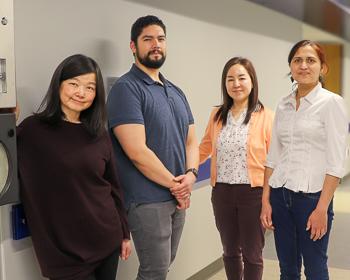
The team responsible for developing the protocol, from left to right, are Jiwon Ryu, Jair Montford, Tea Soon Park, and Devika Bose. Other scientists who helped develop the protocol are Rishabh Hirday, Russell Quinn, Sheela Panicker Jacob, Ruchi Sharma, and Kapil Bharti.
From IPS cells to monocytes takes 3 to 4 weeks after which the cells can be harvested about two times per week for up to four weeks or grown into macrophages, dendritic cells, or microglia. Cells can be frozen, thawed, and regrown for experimentation.
Information about
NEI Ocular and Stem Cell Translational Research Section
More NEI research news
Reference: Park TS, Hirday R, Quinn R, et al. Differentiation of monocytes and polarized M1/M2 macrophages from human induced pluripotent stem cells. STAR Protoc. Jan 12 2024;5(1):102827. doi:10.1016/j.xpro.2023.102827

IMAGES
COMMENTS
The research and development department performs product research after a product or service proposal. This may include conducting a series of tests, surveys and other research. The purpose of the research is to find what makes the product useful, the specifications of how the team should build it, the best methods of marketing it and the ...
The global investment in research and development (R&D) is staggering. In 2019 alone, organizations around the world spent $2.3 trillion on R&D—the equivalent of roughly 2 percent of global GDP—about half of which came from industry and the remainder from governments and academic institutions. ... how the R&D team will execute the strategy ...
Research And Development - R&D: Research and development (R&D) refers to the investigative activities a business conducts to improve existing products and procedures or to lead to the development ...
Our R&D team. Learn more about the backgrounds, scientific pursuits and personal interests of members of our R&D team. These individuals are committed to pursuing Bristol Myers Squibb's goal of discovering, developing and delivering transformational medicines to patients. Researchers.
A set of winning design principles. In the ideal R&D organization, responsibilities are clearly established, and interfaces between and among teams (internal and external) are seamless and transparent. These requirements, although not new, have become even more important of late, particularly when more teams are working remotely.
How to Structure a Research and Development Company. Determining how to structure a Research and Development (R&D) company and corresponding r&d centers is not easy and has several considerations. However, there are 2 general R&D team structure frameworks that most businesses and organizations use as a guide.
Chasmine joined the Office of the Vice Provost for Research in 2017. As Director for Research, she provides leadership, direction and financial oversight for the Bloomberg Distinguished Professorships (BDP) program, university awards programs, and Research Development Team. Email: [email protected] Phone: 443-927-1960.
Research and development (R&D) is a vital function for any organization that wants to innovate, improve, and stay ahead of the competition. But R&D is not just about creating new products or ...
Nestlé's Research and Development organization is the largest in the food and beverage industry. We have over 4,100 employees working at 23 sites worldwide. Our R&D organization encompasses Nestlé Research, which works on cross-category, fundamental research, and our wider Nestlé R&D organization dedicated to category-focused product and ...
In 2019 alone, organizations around the world spent $2.3 trillion on research and development (R&D). Companies know that research and development is essential for growing as a business. Choosing to avoid R&D practices can easily become the choice between a successful or unsuccessful product. R&D is not an optional phase for organizations.
4. Research Assistant: 5. Statistician: A scientific research team is a group of individuals, working to complete a research project successfully. When run well, the research team members work closely, and have clearly defined roles. Every team member should know their role, and how it plays into the project as a whole.
3 types of R&D. Here are the three main types of research and development: 1. Basic research. When the team conducts basic research, sometimes known as pure or fundamental research, they often focus on learning as much about a subject as possible without having a practical use for it. This type of research allows teams to have a more thorough ...
Research and development is closely linked to innovation. Innovation is a broad term and can be difficult to define. It often refers to those ideas, products, services, and methods/processes that are new and different. R&D activity and projects is one of the main ways a business will seek to innovate.
Here are some common Sub-I or Co-I responsibilities: Assist PIs with various project duties and expectations. Help manage members of the research team. Educate team members and study participants on processes and expectations. Communicate with PIs and stakeholders about project status, updates and milestones.
1. Study a relevant degree. While the R&D field's sheer vastness means there is no single, over-arching research and development degree, there are any number of relevant qualifications it might be relevant to study at the bachelor's level and beyond. R&D jobs tend to be complex, requiring a high level of technical ability and knowhow.
An external R&D team could bring in these niche-specific skills while at the same time providing you with their knowledge of existing technologies. This could provide you with a huge competitive advantage. It's essential for research and development teams to feel that their contributions to the company receive value by upper management.
Companies often spend resources on certain investigative undertakings in an effort to make discoveries that can help develop new products or way of doing things or work towards enhancing pre-existing products or processes. These activities come under the Research and Development (R&D) umbrella. R&D is an important means for achieving future growth and maintaining a relevant product in the market.
Development research: In development research, researchers focus exclusively on applied research to develop new products and improve existing ones. For example, a team of development researchers may test the hypothetical company's new toy or implement feedback obtained from customers.
OVERVIEW [ top] An effective research and development team — one that produces innovative ideas, revenue-generating products, service packages and methods — is crucial to any emerging-growth business. Yet it takes a combination of elements and a different approach by business leaders to foster a team that will consistently push innovation.
26 Most Important R&D KPIs and Metrics. If you want to accurately measure your Research and Development performance but don't where to start, we collected all the necessary R&D KPIs and metrics for you! Also, we are proud to present our R&D Dashboard templates if you need to make the analysis and recording within you Research and Development ...
Key Takeaways. Research and development (R&D) is an essential driver of economic growth as it spurs innovation, invention, and progress. R&D spending can lead to breakthroughs that can drive ...
Cycle of research and development Spending on research and development as share of GDP (2015). Research and development (R&D or R+D; also known in Europe as research and technological development or RTD) is the set of innovative activities undertaken by corporations or governments in developing new services or products, and improving existing ones. Research and development constitutes the ...
The New York Times Research and Development team applies emerging technologies in service of our company's mission to seek the truth and help people understand the world. Using new technologies and formats, we develop technical capabilities for our newsroom and new forms of storytelling for our readers. ... Research & Development. 620 Eighth ...
A new member of the Georgia Artificial Intelligence in Manufacturing (Georgia AIM) leadership team will serve as a key connector between industry and Georgia AIM innovations and workforce development programs.Steven Ferguson, who begins March 16 as a principal research scientist with the Georgia Tech Manufacturing Institute, comes to Georgia AIM from the Technical College System of Georgia (TCSG).
WEST LAFAYETTE, Ind. — A team at the Purdue Applied Research Institute (PARI), the university's research and development center, is using state-of-the-art additive-manufacturing equipment to print a full-scale, fully operational prototype of a supersonic combustion ramjet, or scramjet, an engine that allows aircraft to travel at speeds of Mach 5 and beyond.
According to the NSF, funded projects "seek to transition basic research and discovery into practice — to solve high-impact societal challenges aligned with specific research themes (tracks)." Manheim's team was selected for its transdisciplinary, multi-institutional project "Advancing Source Separation for Equitable Transitions ...
The research team, led by USC Rossier Professor Mary Helen Immordino-Yang, includes Rebecca J.M. Gotlieb, research scientist at UCLA, and Xiao-Fei Yang, assistant research professor at USC Rossier. The published study "Diverse adolescents' transcendent thinking predicts young adult psychosocial outcomes via brain network development" is ...
Scientists at the National Eye Institute have published a protocol for generating immune cells from patient-derived stem cells. The technique, known by the research team as a "monocyte factory," makes possible a theoretically limitless source of human immune cells for research and the development of therapies for a variety of conditions including eye disease.
EVALIDator is maintained by a team from USDA Forest Service Forest Inventory and Analysis (FIA) National Program and The University of Nevada, Las Vegas. The purpose of EVALIDator is to allow users to produce a large variety of population estimates and their sampling errors based on the current Forest Inventory and Analysis Database (FIADB).